Review and Critique of Operations Management and Project Life Cycle at Unilever
VerifiedAdded on 2023/06/18
|23
|5917
|125
AI Summary
This report analyzes the implementation of operations management principles and project life cycle at Unilever. It discusses principles of operation management, Taylor's theory, continuous improvement methods, and provides a continuous improvement plan for Unilever.
Contribute Materials
Your contribution can guide someone’s learning journey. Share your
documents today.
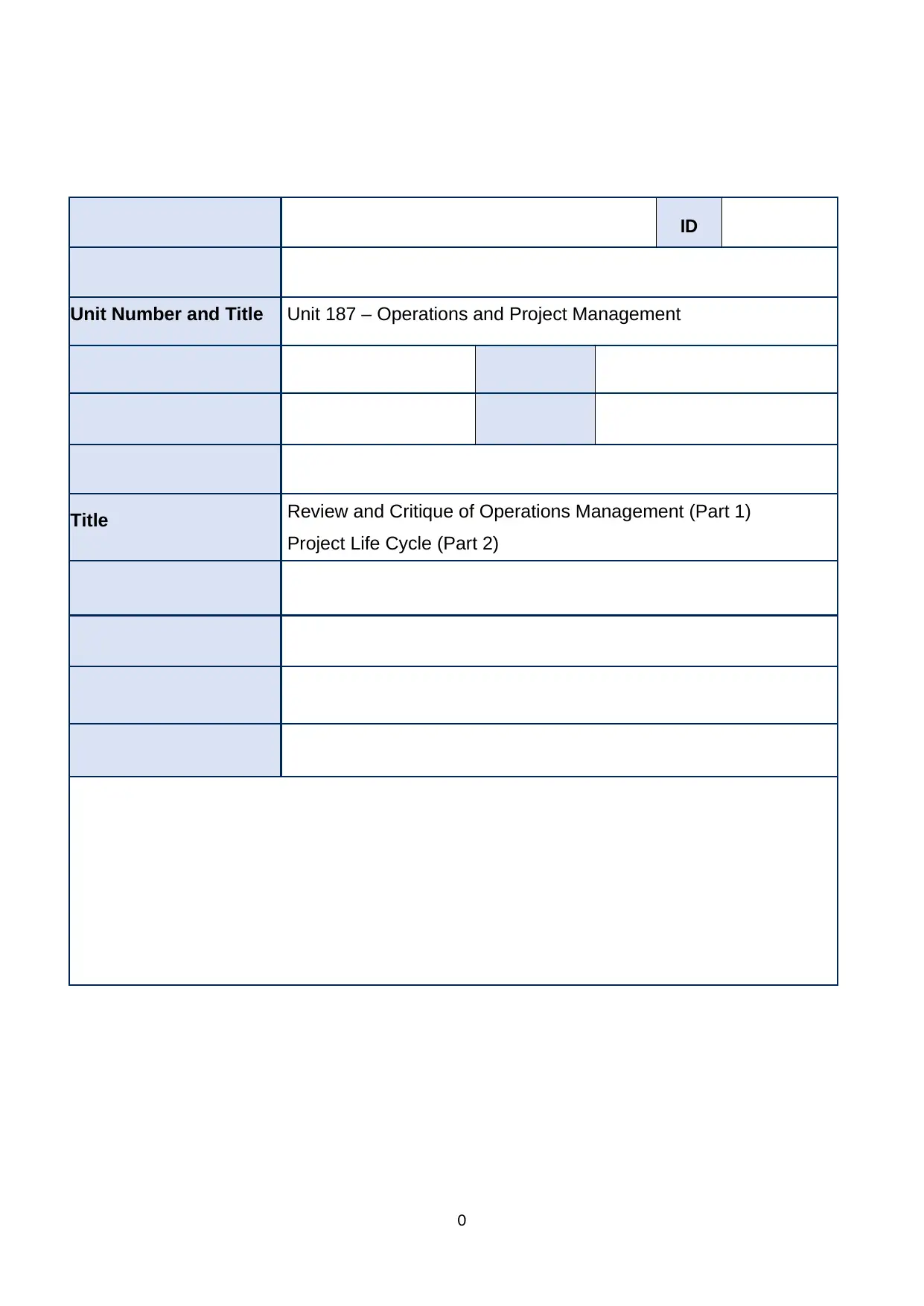
ID
Unit Number and Title Unit 187 – Operations and Project Management
Title Review and Critique of Operations Management (Part 1)
Project Life Cycle (Part 2)
0
Unit Number and Title Unit 187 – Operations and Project Management
Title Review and Critique of Operations Management (Part 1)
Project Life Cycle (Part 2)
0
Secure Best Marks with AI Grader
Need help grading? Try our AI Grader for instant feedback on your assignments.
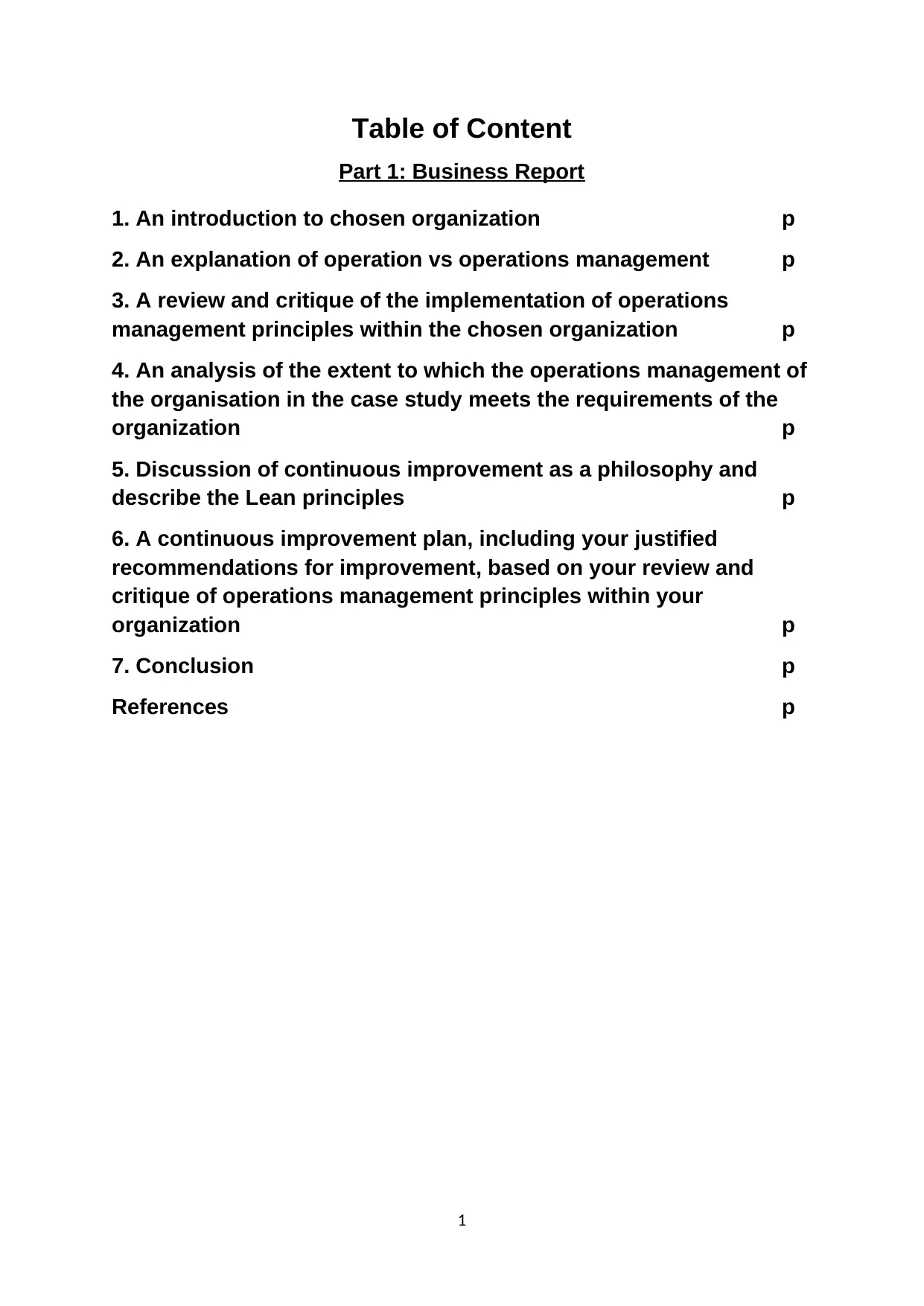
Table of Content
Part 1: Business Report
1. An introduction to chosen organization p
2. An explanation of operation vs operations management p
3. A review and critique of the implementation of operations
management principles within the chosen organization p
4. An analysis of the extent to which the operations management of
the organisation in the case study meets the requirements of the
organization p
5. Discussion of continuous improvement as a philosophy and
describe the Lean principles p
6. A continuous improvement plan, including your justified
recommendations for improvement, based on your review and
critique of operations management principles within your
organization p
7. Conclusion p
References p
1
Part 1: Business Report
1. An introduction to chosen organization p
2. An explanation of operation vs operations management p
3. A review and critique of the implementation of operations
management principles within the chosen organization p
4. An analysis of the extent to which the operations management of
the organisation in the case study meets the requirements of the
organization p
5. Discussion of continuous improvement as a philosophy and
describe the Lean principles p
6. A continuous improvement plan, including your justified
recommendations for improvement, based on your review and
critique of operations management principles within your
organization p
7. Conclusion p
References p
1
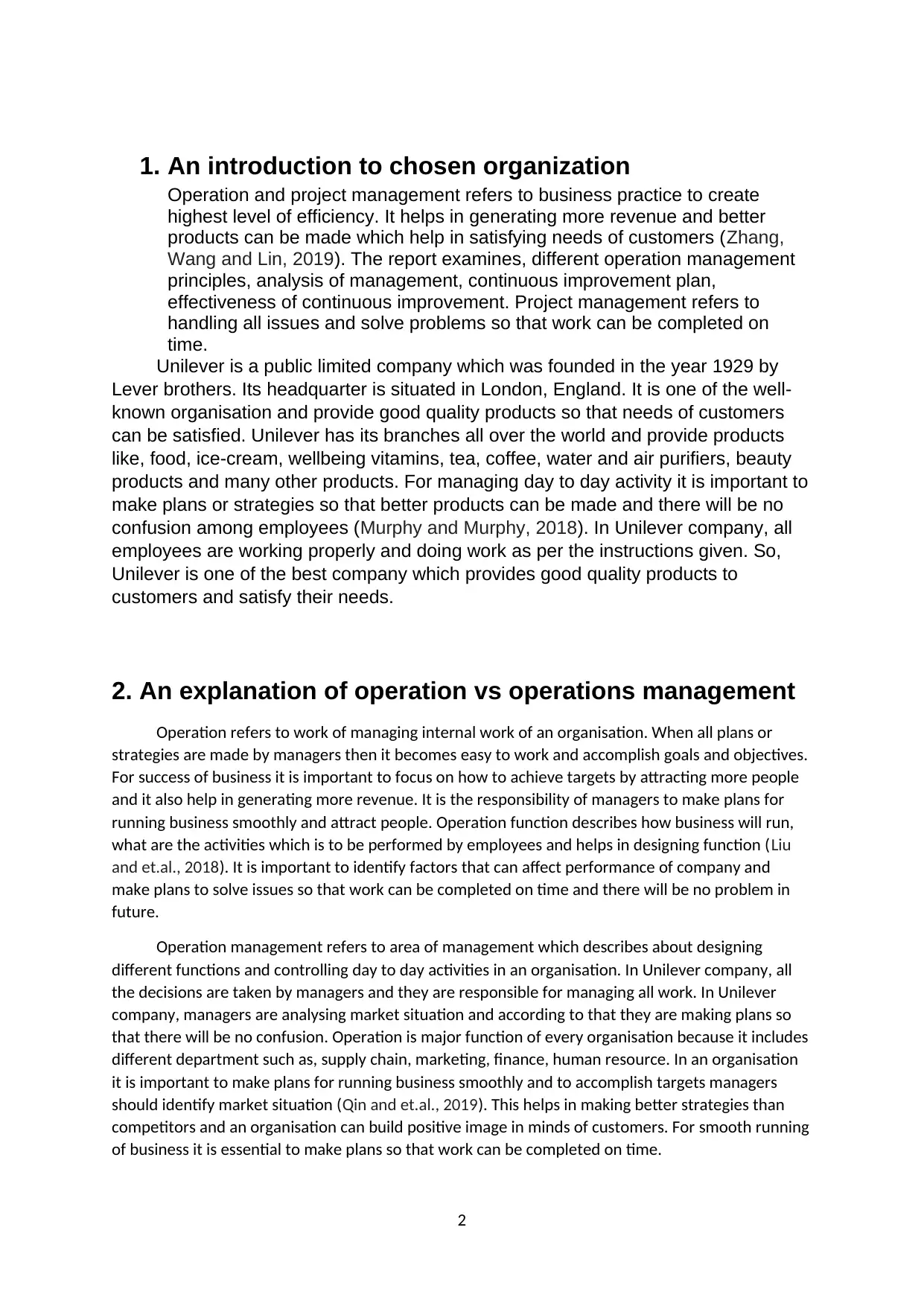
1. An introduction to chosen organization
Operation and project management refers to business practice to create
highest level of efficiency. It helps in generating more revenue and better
products can be made which help in satisfying needs of customers (Zhang,
Wang and Lin, 2019). The report examines, different operation management
principles, analysis of management, continuous improvement plan,
effectiveness of continuous improvement. Project management refers to
handling all issues and solve problems so that work can be completed on
time.
Unilever is a public limited company which was founded in the year 1929 by
Lever brothers. Its headquarter is situated in London, England. It is one of the well-
known organisation and provide good quality products so that needs of customers
can be satisfied. Unilever has its branches all over the world and provide products
like, food, ice-cream, wellbeing vitamins, tea, coffee, water and air purifiers, beauty
products and many other products. For managing day to day activity it is important to
make plans or strategies so that better products can be made and there will be no
confusion among employees (Murphy and Murphy, 2018). In Unilever company, all
employees are working properly and doing work as per the instructions given. So,
Unilever is one of the best company which provides good quality products to
customers and satisfy their needs.
2. An explanation of operation vs operations management
Operation refers to work of managing internal work of an organisation. When all plans or
strategies are made by managers then it becomes easy to work and accomplish goals and objectives.
For success of business it is important to focus on how to achieve targets by attracting more people
and it also help in generating more revenue. It is the responsibility of managers to make plans for
running business smoothly and attract people. Operation function describes how business will run,
what are the activities which is to be performed by employees and helps in designing function (Liu
and et.al., 2018). It is important to identify factors that can affect performance of company and
make plans to solve issues so that work can be completed on time and there will be no problem in
future.
Operation management refers to area of management which describes about designing
different functions and controlling day to day activities in an organisation. In Unilever company, all
the decisions are taken by managers and they are responsible for managing all work. In Unilever
company, managers are analysing market situation and according to that they are making plans so
that there will be no confusion. Operation is major function of every organisation because it includes
different department such as, supply chain, marketing, finance, human resource. In an organisation
it is important to make plans for running business smoothly and to accomplish targets managers
should identify market situation (Qin and et.al., 2019). This helps in making better strategies than
competitors and an organisation can build positive image in minds of customers. For smooth running
of business it is essential to make plans so that work can be completed on time.
2
Operation and project management refers to business practice to create
highest level of efficiency. It helps in generating more revenue and better
products can be made which help in satisfying needs of customers (Zhang,
Wang and Lin, 2019). The report examines, different operation management
principles, analysis of management, continuous improvement plan,
effectiveness of continuous improvement. Project management refers to
handling all issues and solve problems so that work can be completed on
time.
Unilever is a public limited company which was founded in the year 1929 by
Lever brothers. Its headquarter is situated in London, England. It is one of the well-
known organisation and provide good quality products so that needs of customers
can be satisfied. Unilever has its branches all over the world and provide products
like, food, ice-cream, wellbeing vitamins, tea, coffee, water and air purifiers, beauty
products and many other products. For managing day to day activity it is important to
make plans or strategies so that better products can be made and there will be no
confusion among employees (Murphy and Murphy, 2018). In Unilever company, all
employees are working properly and doing work as per the instructions given. So,
Unilever is one of the best company which provides good quality products to
customers and satisfy their needs.
2. An explanation of operation vs operations management
Operation refers to work of managing internal work of an organisation. When all plans or
strategies are made by managers then it becomes easy to work and accomplish goals and objectives.
For success of business it is important to focus on how to achieve targets by attracting more people
and it also help in generating more revenue. It is the responsibility of managers to make plans for
running business smoothly and attract people. Operation function describes how business will run,
what are the activities which is to be performed by employees and helps in designing function (Liu
and et.al., 2018). It is important to identify factors that can affect performance of company and
make plans to solve issues so that work can be completed on time and there will be no problem in
future.
Operation management refers to area of management which describes about designing
different functions and controlling day to day activities in an organisation. In Unilever company, all
the decisions are taken by managers and they are responsible for managing all work. In Unilever
company, managers are analysing market situation and according to that they are making plans so
that there will be no confusion. Operation is major function of every organisation because it includes
different department such as, supply chain, marketing, finance, human resource. In an organisation
it is important to make plans for running business smoothly and to accomplish targets managers
should identify market situation (Qin and et.al., 2019). This helps in making better strategies than
competitors and an organisation can build positive image in minds of customers. For smooth running
of business it is essential to make plans so that work can be completed on time.
2

3. A review and critique of the implementation of
operations management principles within the chosen
organization
There are some operation management principles which can be applied by an organisation to
accomplish goals and objectives. Principles of operation management are: Rapid improvement
First principle of operation management is rapid improvement means changes should be made in
plans or strategies so that goals can be accomplished. This helps in making better plans or strategies
and business can run smoothly. For satisfying needs of customers, managers should make changes in
plans and try to implement best plan so that targets can be achieved. Managers should check
continuously that whether changes are required or not and make improvements accordingly so that
there is less chance of mistake (Rosli, Muhammad Tamyez and Zahari, 2020). Know the competition
Another principle of operation management is to know about the competitors. It is the responsibility
of managers to gather all the details about competitors, their strengths, weakness, opportunity and
threats. This helps in making better plans or strategies for future growth and development of
organisation. Managers should determine these points and solve issues to avoid confusion among
employees and work can be completed on time. Organise resources
Next principle of operation management is to organise resources so that production can be done
properly and there will be less chances of mistake. For accomplishing targets, managers distribute
work among employees and give instructions to perform task properly within given time period. So,
this principle can be applied by an organisation to run business smoothly and to avoid
misunderstanding among employees (Choudhry, 2018).
4. An analysis of the extent to which the operations
management of the organisation in the case study meets
the requirements of the organization
Taylor theory of scientific management
According to Taylor there are four principles which can be applied in Unilever company to motivate
employees and to boost their confidence so that they can work efficiently and focus on
accomplishing targets. Four principles given by Taylor are:
Science, not rule of thumb – According to Taylor, this principle means managers should take
decisions after analysing all the situation and they should gather all the information
properly. It is important to make plans so that business can be run smoothly and to avoid
3
operations management principles within the chosen
organization
There are some operation management principles which can be applied by an organisation to
accomplish goals and objectives. Principles of operation management are: Rapid improvement
First principle of operation management is rapid improvement means changes should be made in
plans or strategies so that goals can be accomplished. This helps in making better plans or strategies
and business can run smoothly. For satisfying needs of customers, managers should make changes in
plans and try to implement best plan so that targets can be achieved. Managers should check
continuously that whether changes are required or not and make improvements accordingly so that
there is less chance of mistake (Rosli, Muhammad Tamyez and Zahari, 2020). Know the competition
Another principle of operation management is to know about the competitors. It is the responsibility
of managers to gather all the details about competitors, their strengths, weakness, opportunity and
threats. This helps in making better plans or strategies for future growth and development of
organisation. Managers should determine these points and solve issues to avoid confusion among
employees and work can be completed on time. Organise resources
Next principle of operation management is to organise resources so that production can be done
properly and there will be less chances of mistake. For accomplishing targets, managers distribute
work among employees and give instructions to perform task properly within given time period. So,
this principle can be applied by an organisation to run business smoothly and to avoid
misunderstanding among employees (Choudhry, 2018).
4. An analysis of the extent to which the operations
management of the organisation in the case study meets
the requirements of the organization
Taylor theory of scientific management
According to Taylor there are four principles which can be applied in Unilever company to motivate
employees and to boost their confidence so that they can work efficiently and focus on
accomplishing targets. Four principles given by Taylor are:
Science, not rule of thumb – According to Taylor, this principle means managers should take
decisions after analysing all the situation and they should gather all the information
properly. It is important to make plans so that business can be run smoothly and to avoid
3
Secure Best Marks with AI Grader
Need help grading? Try our AI Grader for instant feedback on your assignments.

confusion among members. It means rules should be applied in every company to maintain
equality among employees and it also helps in building positive image in minds of
customers. For satisfying needs of employees and to motivate them it is important to take
correct decisions (Shulga and et.al., 2021). Harmony, not discord
Another principle is harmony, not discord which means that in an organisation everyone should
work as a team and solve all the issues. This helps in completing work on time and better decisions
can be taken which is beneficial for growth and development of Unilever company. When employees
are happy then it becomes easy to work and goals of organisation are achieved. Cooperation, not individualism
Next principle is cooperation, not individualism, according to Taylor all employees should work as a
team or in group. There must be no confusion or misunderstanding among employees related to
work and all should focus on accomplishing targets. It is important to cooperate each other and
focus on completing work on time.
These principles are applied in Unilever organisation and managers divide work among
employees so that there will be no confusion and it also help in reducing confusion or
misunderstanding between workers. All employees have to work according to the instructions given
to them and there must be no issue (Atkinson, Gesing, Montagnat and Taylor, 2017).
The main objective of Unilever company is to satisfy needs of people and provide them good
quality products. For fulfilling targets it is important to make plans or strategies so that employees
can perform best and suggest new ideas which is beneficial in growth and development of company.
For earning more revenue, managers should make products according to need of customers and
quality should be good. Nowadays, people want good quality products at low prices and this helps in
increasing productivity of firm. Motivating employees also helps in increasing overall productivity of
organisation because when employees are working efficiently then goals are accomplished.
5. Discussion of continuous improvement as a philosophy
and describe the Lean principles
In every organisation it is essential to make changes or improvements so that work can be
completed on time and there will be no confusion or misunderstanding. There are some method of
continuous improvement which can be applied by managers of Unilever company to run business
smoothly and to focus on accomplishing targets (Khan and et.al., 2019).
Methods of lean production
Six sigma
Six sigma method refers to some stages which help in continuous improvement like, define,
measure, analyse, improve and control. This is a method which can be applied by managers of
Unilever company to improve performance and perform better than others. This has several stages
4
equality among employees and it also helps in building positive image in minds of
customers. For satisfying needs of employees and to motivate them it is important to take
correct decisions (Shulga and et.al., 2021). Harmony, not discord
Another principle is harmony, not discord which means that in an organisation everyone should
work as a team and solve all the issues. This helps in completing work on time and better decisions
can be taken which is beneficial for growth and development of Unilever company. When employees
are happy then it becomes easy to work and goals of organisation are achieved. Cooperation, not individualism
Next principle is cooperation, not individualism, according to Taylor all employees should work as a
team or in group. There must be no confusion or misunderstanding among employees related to
work and all should focus on accomplishing targets. It is important to cooperate each other and
focus on completing work on time.
These principles are applied in Unilever organisation and managers divide work among
employees so that there will be no confusion and it also help in reducing confusion or
misunderstanding between workers. All employees have to work according to the instructions given
to them and there must be no issue (Atkinson, Gesing, Montagnat and Taylor, 2017).
The main objective of Unilever company is to satisfy needs of people and provide them good
quality products. For fulfilling targets it is important to make plans or strategies so that employees
can perform best and suggest new ideas which is beneficial in growth and development of company.
For earning more revenue, managers should make products according to need of customers and
quality should be good. Nowadays, people want good quality products at low prices and this helps in
increasing productivity of firm. Motivating employees also helps in increasing overall productivity of
organisation because when employees are working efficiently then goals are accomplished.
5. Discussion of continuous improvement as a philosophy
and describe the Lean principles
In every organisation it is essential to make changes or improvements so that work can be
completed on time and there will be no confusion or misunderstanding. There are some method of
continuous improvement which can be applied by managers of Unilever company to run business
smoothly and to focus on accomplishing targets (Khan and et.al., 2019).
Methods of lean production
Six sigma
Six sigma method refers to some stages which help in continuous improvement like, define,
measure, analyse, improve and control. This is a method which can be applied by managers of
Unilever company to improve performance and perform better than others. This has several stages
4
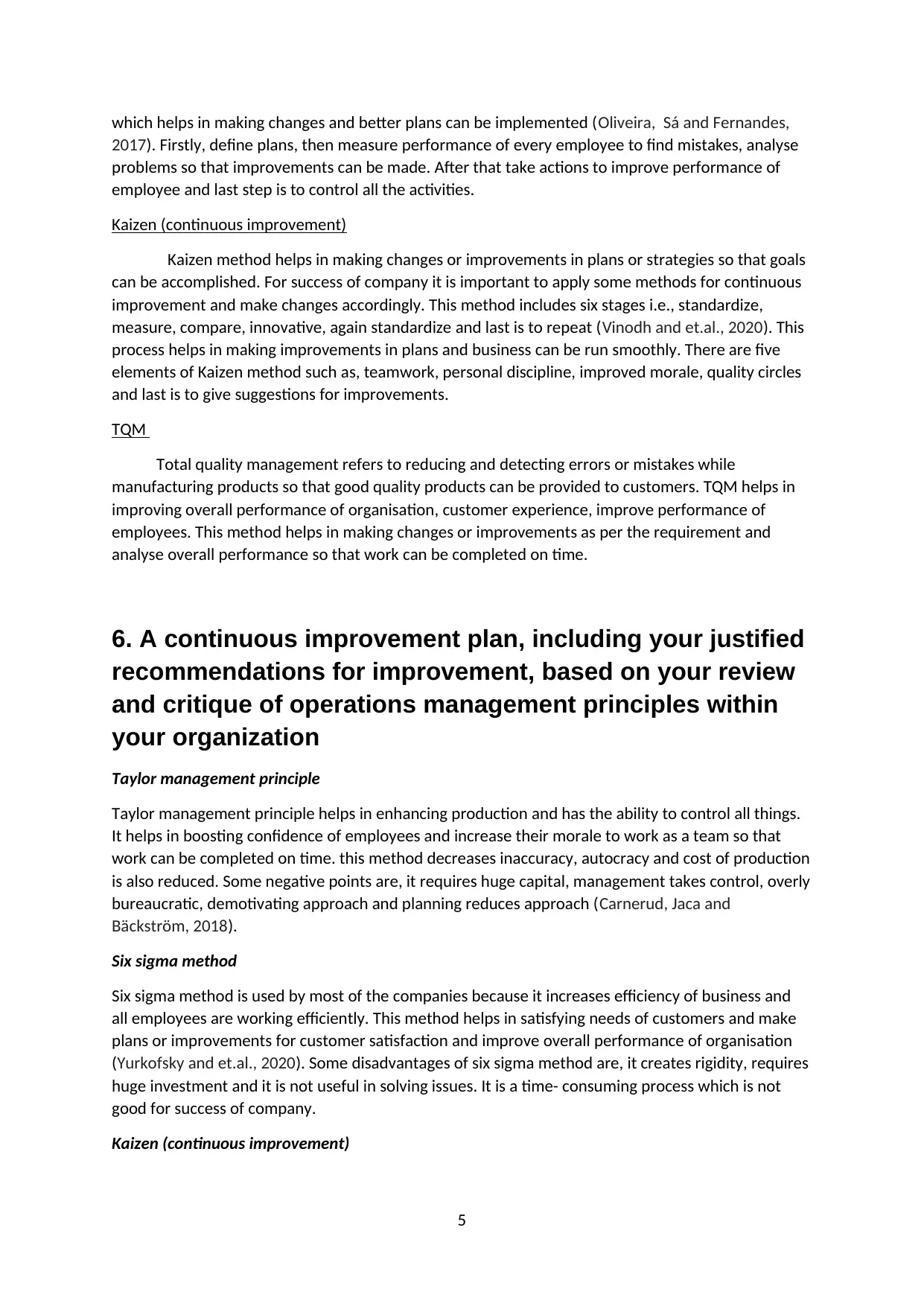
which helps in making changes and better plans can be implemented (Oliveira, Sá and Fernandes,
2017). Firstly, define plans, then measure performance of every employee to find mistakes, analyse
problems so that improvements can be made. After that take actions to improve performance of
employee and last step is to control all the activities.
Kaizen (continuous improvement)
Kaizen method helps in making changes or improvements in plans or strategies so that goals
can be accomplished. For success of company it is important to apply some methods for continuous
improvement and make changes accordingly. This method includes six stages i.e., standardize,
measure, compare, innovative, again standardize and last is to repeat (Vinodh and et.al., 2020). This
process helps in making improvements in plans and business can be run smoothly. There are five
elements of Kaizen method such as, teamwork, personal discipline, improved morale, quality circles
and last is to give suggestions for improvements.
TQM
Total quality management refers to reducing and detecting errors or mistakes while
manufacturing products so that good quality products can be provided to customers. TQM helps in
improving overall performance of organisation, customer experience, improve performance of
employees. This method helps in making changes or improvements as per the requirement and
analyse overall performance so that work can be completed on time.
6. A continuous improvement plan, including your justified
recommendations for improvement, based on your review
and critique of operations management principles within
your organization
Taylor management principle
Taylor management principle helps in enhancing production and has the ability to control all things.
It helps in boosting confidence of employees and increase their morale to work as a team so that
work can be completed on time. this method decreases inaccuracy, autocracy and cost of production
is also reduced. Some negative points are, it requires huge capital, management takes control, overly
bureaucratic, demotivating approach and planning reduces approach (Carnerud, Jaca and
Bäckström, 2018).
Six sigma method
Six sigma method is used by most of the companies because it increases efficiency of business and
all employees are working efficiently. This method helps in satisfying needs of customers and make
plans or improvements for customer satisfaction and improve overall performance of organisation
(Yurkofsky and et.al., 2020). Some disadvantages of six sigma method are, it creates rigidity, requires
huge investment and it is not useful in solving issues. It is a time- consuming process which is not
good for success of company.
Kaizen (continuous improvement)
5
2017). Firstly, define plans, then measure performance of every employee to find mistakes, analyse
problems so that improvements can be made. After that take actions to improve performance of
employee and last step is to control all the activities.
Kaizen (continuous improvement)
Kaizen method helps in making changes or improvements in plans or strategies so that goals
can be accomplished. For success of company it is important to apply some methods for continuous
improvement and make changes accordingly. This method includes six stages i.e., standardize,
measure, compare, innovative, again standardize and last is to repeat (Vinodh and et.al., 2020). This
process helps in making improvements in plans and business can be run smoothly. There are five
elements of Kaizen method such as, teamwork, personal discipline, improved morale, quality circles
and last is to give suggestions for improvements.
TQM
Total quality management refers to reducing and detecting errors or mistakes while
manufacturing products so that good quality products can be provided to customers. TQM helps in
improving overall performance of organisation, customer experience, improve performance of
employees. This method helps in making changes or improvements as per the requirement and
analyse overall performance so that work can be completed on time.
6. A continuous improvement plan, including your justified
recommendations for improvement, based on your review
and critique of operations management principles within
your organization
Taylor management principle
Taylor management principle helps in enhancing production and has the ability to control all things.
It helps in boosting confidence of employees and increase their morale to work as a team so that
work can be completed on time. this method decreases inaccuracy, autocracy and cost of production
is also reduced. Some negative points are, it requires huge capital, management takes control, overly
bureaucratic, demotivating approach and planning reduces approach (Carnerud, Jaca and
Bäckström, 2018).
Six sigma method
Six sigma method is used by most of the companies because it increases efficiency of business and
all employees are working efficiently. This method helps in satisfying needs of customers and make
plans or improvements for customer satisfaction and improve overall performance of organisation
(Yurkofsky and et.al., 2020). Some disadvantages of six sigma method are, it creates rigidity, requires
huge investment and it is not useful in solving issues. It is a time- consuming process which is not
good for success of company.
Kaizen (continuous improvement)
5
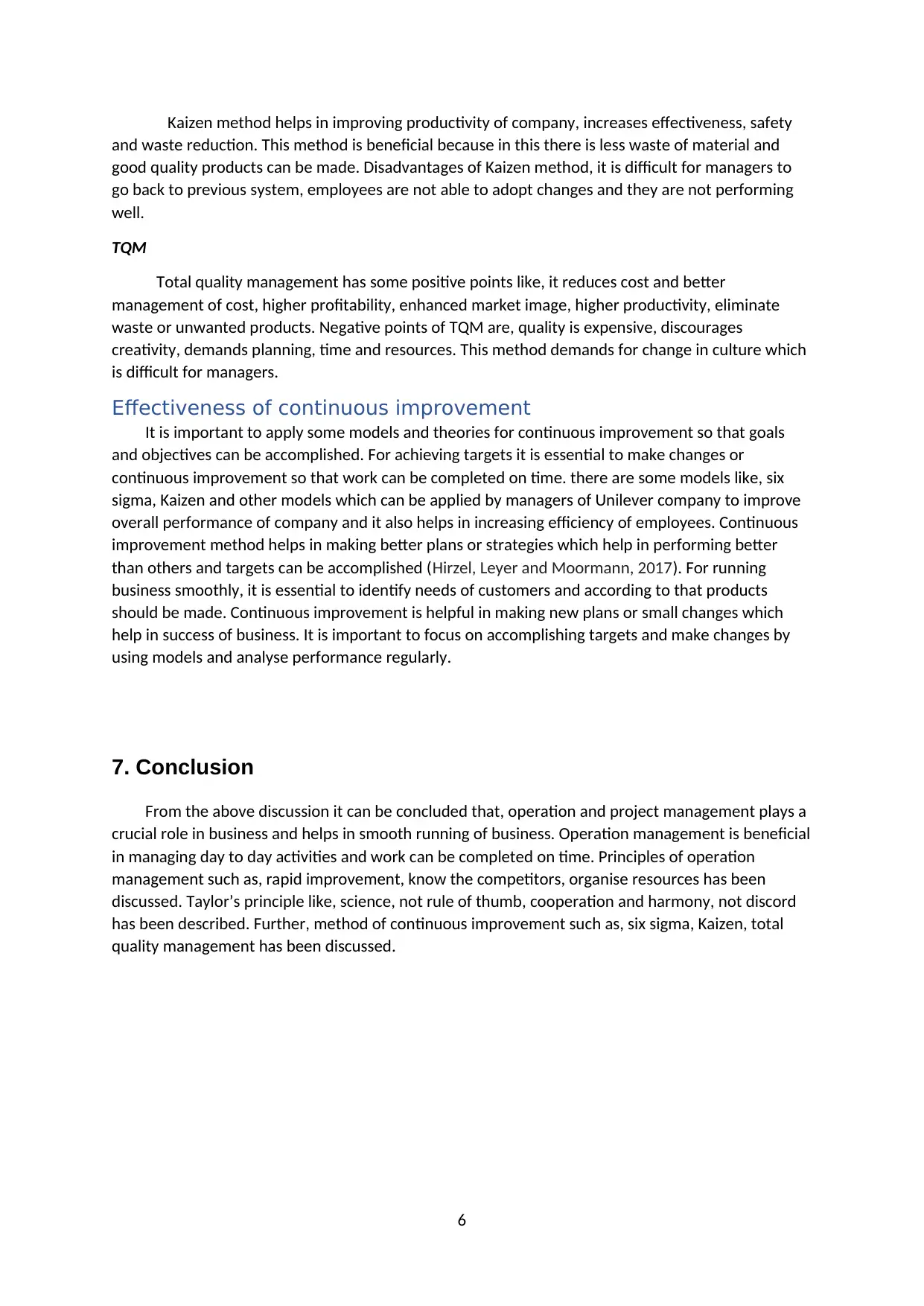
Kaizen method helps in improving productivity of company, increases effectiveness, safety
and waste reduction. This method is beneficial because in this there is less waste of material and
good quality products can be made. Disadvantages of Kaizen method, it is difficult for managers to
go back to previous system, employees are not able to adopt changes and they are not performing
well.
TQM
Total quality management has some positive points like, it reduces cost and better
management of cost, higher profitability, enhanced market image, higher productivity, eliminate
waste or unwanted products. Negative points of TQM are, quality is expensive, discourages
creativity, demands planning, time and resources. This method demands for change in culture which
is difficult for managers.
Effectiveness of continuous improvement
It is important to apply some models and theories for continuous improvement so that goals
and objectives can be accomplished. For achieving targets it is essential to make changes or
continuous improvement so that work can be completed on time. there are some models like, six
sigma, Kaizen and other models which can be applied by managers of Unilever company to improve
overall performance of company and it also helps in increasing efficiency of employees. Continuous
improvement method helps in making better plans or strategies which help in performing better
than others and targets can be accomplished (Hirzel, Leyer and Moormann, 2017). For running
business smoothly, it is essential to identify needs of customers and according to that products
should be made. Continuous improvement is helpful in making new plans or small changes which
help in success of business. It is important to focus on accomplishing targets and make changes by
using models and analyse performance regularly.
7. Conclusion
From the above discussion it can be concluded that, operation and project management plays a
crucial role in business and helps in smooth running of business. Operation management is beneficial
in managing day to day activities and work can be completed on time. Principles of operation
management such as, rapid improvement, know the competitors, organise resources has been
discussed. Taylor’s principle like, science, not rule of thumb, cooperation and harmony, not discord
has been described. Further, method of continuous improvement such as, six sigma, Kaizen, total
quality management has been discussed.
6
and waste reduction. This method is beneficial because in this there is less waste of material and
good quality products can be made. Disadvantages of Kaizen method, it is difficult for managers to
go back to previous system, employees are not able to adopt changes and they are not performing
well.
TQM
Total quality management has some positive points like, it reduces cost and better
management of cost, higher profitability, enhanced market image, higher productivity, eliminate
waste or unwanted products. Negative points of TQM are, quality is expensive, discourages
creativity, demands planning, time and resources. This method demands for change in culture which
is difficult for managers.
Effectiveness of continuous improvement
It is important to apply some models and theories for continuous improvement so that goals
and objectives can be accomplished. For achieving targets it is essential to make changes or
continuous improvement so that work can be completed on time. there are some models like, six
sigma, Kaizen and other models which can be applied by managers of Unilever company to improve
overall performance of company and it also helps in increasing efficiency of employees. Continuous
improvement method helps in making better plans or strategies which help in performing better
than others and targets can be accomplished (Hirzel, Leyer and Moormann, 2017). For running
business smoothly, it is essential to identify needs of customers and according to that products
should be made. Continuous improvement is helpful in making new plans or small changes which
help in success of business. It is important to focus on accomplishing targets and make changes by
using models and analyse performance regularly.
7. Conclusion
From the above discussion it can be concluded that, operation and project management plays a
crucial role in business and helps in smooth running of business. Operation management is beneficial
in managing day to day activities and work can be completed on time. Principles of operation
management such as, rapid improvement, know the competitors, organise resources has been
discussed. Taylor’s principle like, science, not rule of thumb, cooperation and harmony, not discord
has been described. Further, method of continuous improvement such as, six sigma, Kaizen, total
quality management has been discussed.
6
Paraphrase This Document
Need a fresh take? Get an instant paraphrase of this document with our AI Paraphraser
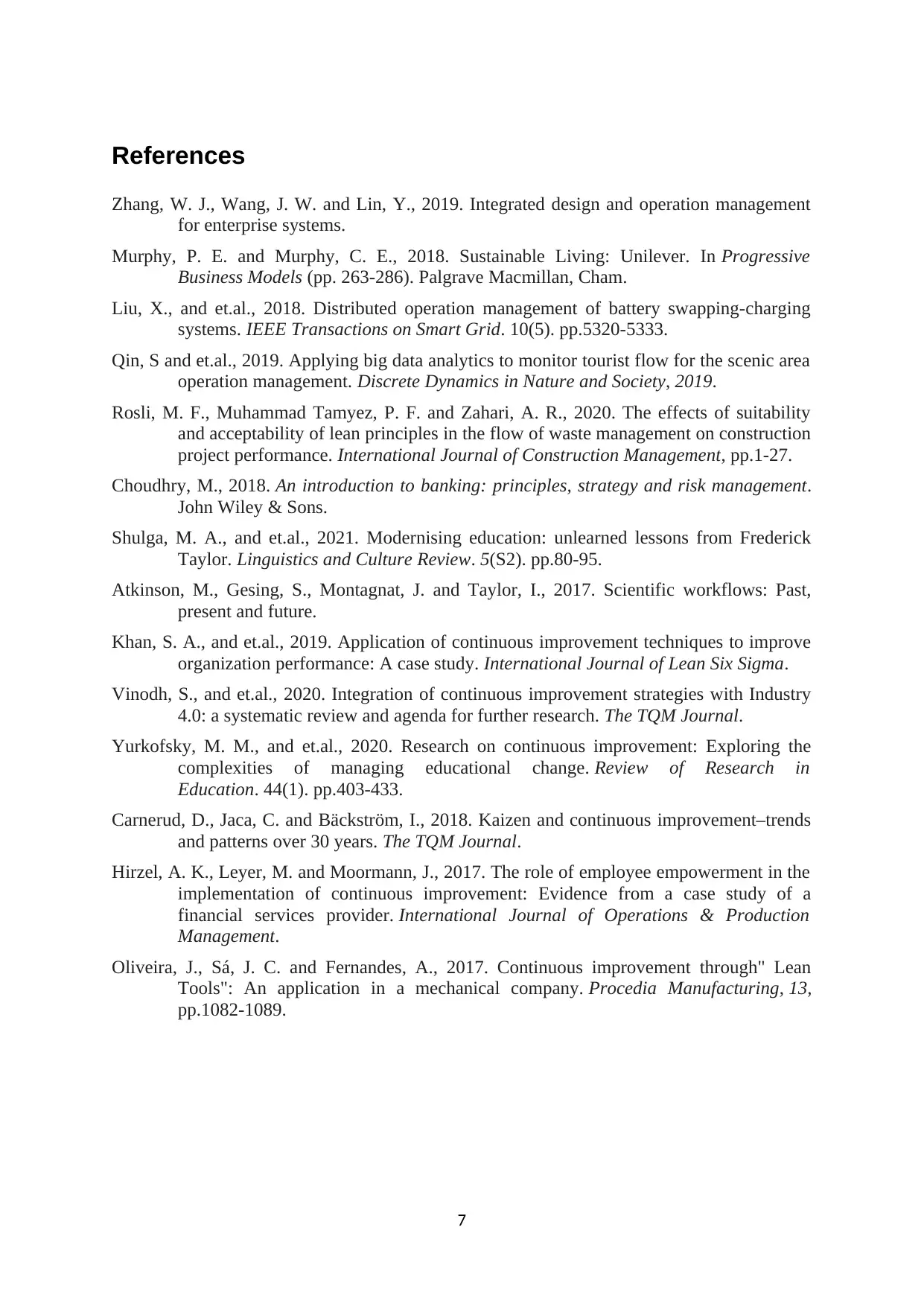
References
Zhang, W. J., Wang, J. W. and Lin, Y., 2019. Integrated design and operation management
for enterprise systems.
Murphy, P. E. and Murphy, C. E., 2018. Sustainable Living: Unilever. In Progressive
Business Models (pp. 263-286). Palgrave Macmillan, Cham.
Liu, X., and et.al., 2018. Distributed operation management of battery swapping-charging
systems. IEEE Transactions on Smart Grid. 10(5). pp.5320-5333.
Qin, S and et.al., 2019. Applying big data analytics to monitor tourist flow for the scenic area
operation management. Discrete Dynamics in Nature and Society, 2019.
Rosli, M. F., Muhammad Tamyez, P. F. and Zahari, A. R., 2020. The effects of suitability
and acceptability of lean principles in the flow of waste management on construction
project performance. International Journal of Construction Management, pp.1-27.
Choudhry, M., 2018. An introduction to banking: principles, strategy and risk management.
John Wiley & Sons.
Shulga, M. A., and et.al., 2021. Modernising education: unlearned lessons from Frederick
Taylor. Linguistics and Culture Review. 5(S2). pp.80-95.
Atkinson, M., Gesing, S., Montagnat, J. and Taylor, I., 2017. Scientific workflows: Past,
present and future.
Khan, S. A., and et.al., 2019. Application of continuous improvement techniques to improve
organization performance: A case study. International Journal of Lean Six Sigma.
Vinodh, S., and et.al., 2020. Integration of continuous improvement strategies with Industry
4.0: a systematic review and agenda for further research. The TQM Journal.
Yurkofsky, M. M., and et.al., 2020. Research on continuous improvement: Exploring the
complexities of managing educational change. Review of Research in
Education. 44(1). pp.403-433.
Carnerud, D., Jaca, C. and Bäckström, I., 2018. Kaizen and continuous improvement–trends
and patterns over 30 years. The TQM Journal.
Hirzel, A. K., Leyer, M. and Moormann, J., 2017. The role of employee empowerment in the
implementation of continuous improvement: Evidence from a case study of a
financial services provider. International Journal of Operations & Production
Management.
Oliveira, J., Sá, J. C. and Fernandes, A., 2017. Continuous improvement through" Lean
Tools": An application in a mechanical company. Procedia Manufacturing, 13,
pp.1082-1089.
7
Zhang, W. J., Wang, J. W. and Lin, Y., 2019. Integrated design and operation management
for enterprise systems.
Murphy, P. E. and Murphy, C. E., 2018. Sustainable Living: Unilever. In Progressive
Business Models (pp. 263-286). Palgrave Macmillan, Cham.
Liu, X., and et.al., 2018. Distributed operation management of battery swapping-charging
systems. IEEE Transactions on Smart Grid. 10(5). pp.5320-5333.
Qin, S and et.al., 2019. Applying big data analytics to monitor tourist flow for the scenic area
operation management. Discrete Dynamics in Nature and Society, 2019.
Rosli, M. F., Muhammad Tamyez, P. F. and Zahari, A. R., 2020. The effects of suitability
and acceptability of lean principles in the flow of waste management on construction
project performance. International Journal of Construction Management, pp.1-27.
Choudhry, M., 2018. An introduction to banking: principles, strategy and risk management.
John Wiley & Sons.
Shulga, M. A., and et.al., 2021. Modernising education: unlearned lessons from Frederick
Taylor. Linguistics and Culture Review. 5(S2). pp.80-95.
Atkinson, M., Gesing, S., Montagnat, J. and Taylor, I., 2017. Scientific workflows: Past,
present and future.
Khan, S. A., and et.al., 2019. Application of continuous improvement techniques to improve
organization performance: A case study. International Journal of Lean Six Sigma.
Vinodh, S., and et.al., 2020. Integration of continuous improvement strategies with Industry
4.0: a systematic review and agenda for further research. The TQM Journal.
Yurkofsky, M. M., and et.al., 2020. Research on continuous improvement: Exploring the
complexities of managing educational change. Review of Research in
Education. 44(1). pp.403-433.
Carnerud, D., Jaca, C. and Bäckström, I., 2018. Kaizen and continuous improvement–trends
and patterns over 30 years. The TQM Journal.
Hirzel, A. K., Leyer, M. and Moormann, J., 2017. The role of employee empowerment in the
implementation of continuous improvement: Evidence from a case study of a
financial services provider. International Journal of Operations & Production
Management.
Oliveira, J., Sá, J. C. and Fernandes, A., 2017. Continuous improvement through" Lean
Tools": An application in a mechanical company. Procedia Manufacturing, 13,
pp.1082-1089.
7
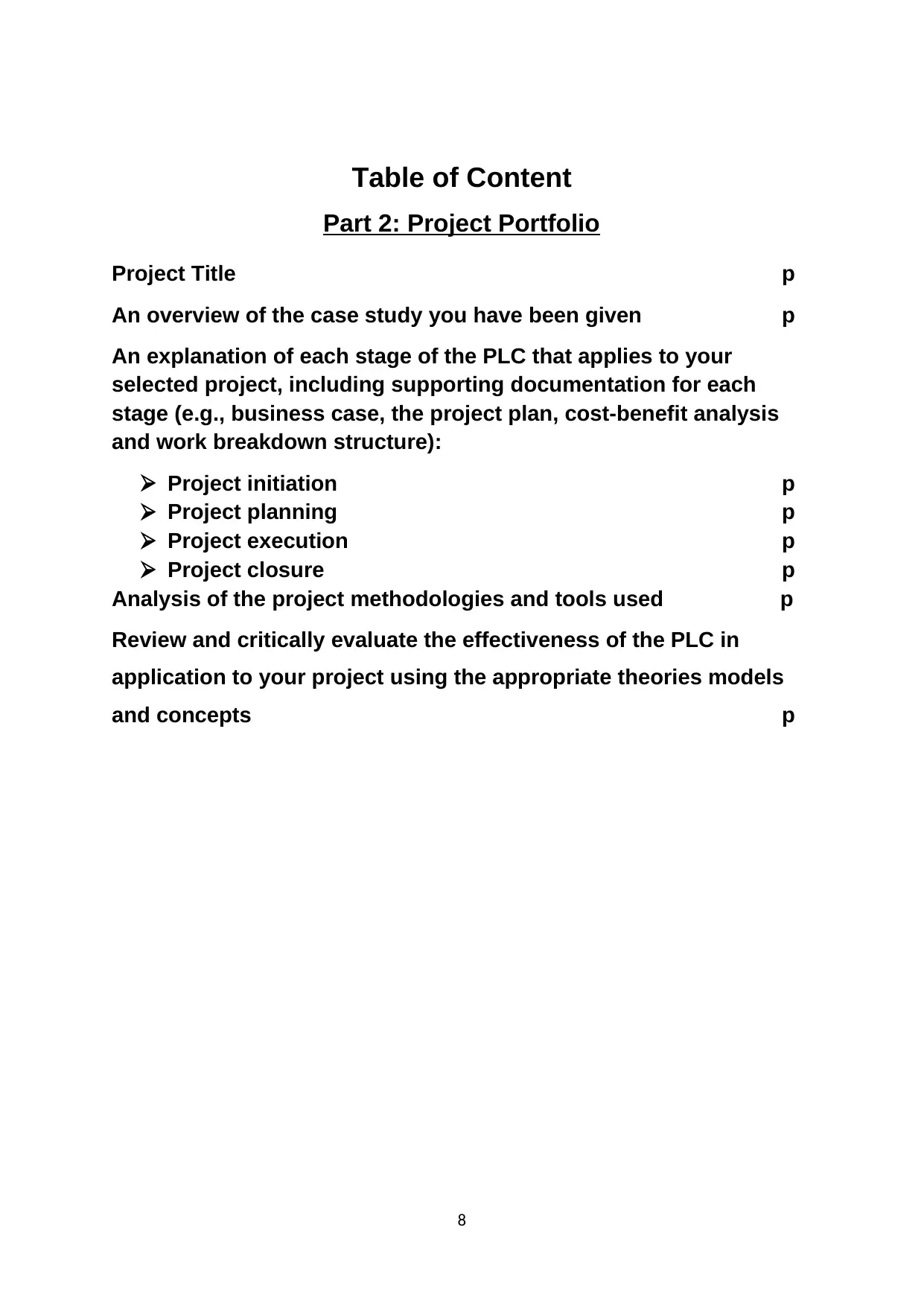
Table of Content
Part 2: Project Portfolio
Project Title p
An overview of the case study you have been given p
An explanation of each stage of the PLC that applies to your
selected project, including supporting documentation for each
stage (e.g., business case, the project plan, cost-benefit analysis
and work breakdown structure):
Project initiation p
Project planning p
Project execution p
Project closure p
Analysis of the project methodologies and tools used p
Review and critically evaluate the effectiveness of the PLC in
application to your project using the appropriate theories models
and concepts p
8
Part 2: Project Portfolio
Project Title p
An overview of the case study you have been given p
An explanation of each stage of the PLC that applies to your
selected project, including supporting documentation for each
stage (e.g., business case, the project plan, cost-benefit analysis
and work breakdown structure):
Project initiation p
Project planning p
Project execution p
Project closure p
Analysis of the project methodologies and tools used p
Review and critically evaluate the effectiveness of the PLC in
application to your project using the appropriate theories models
and concepts p
8
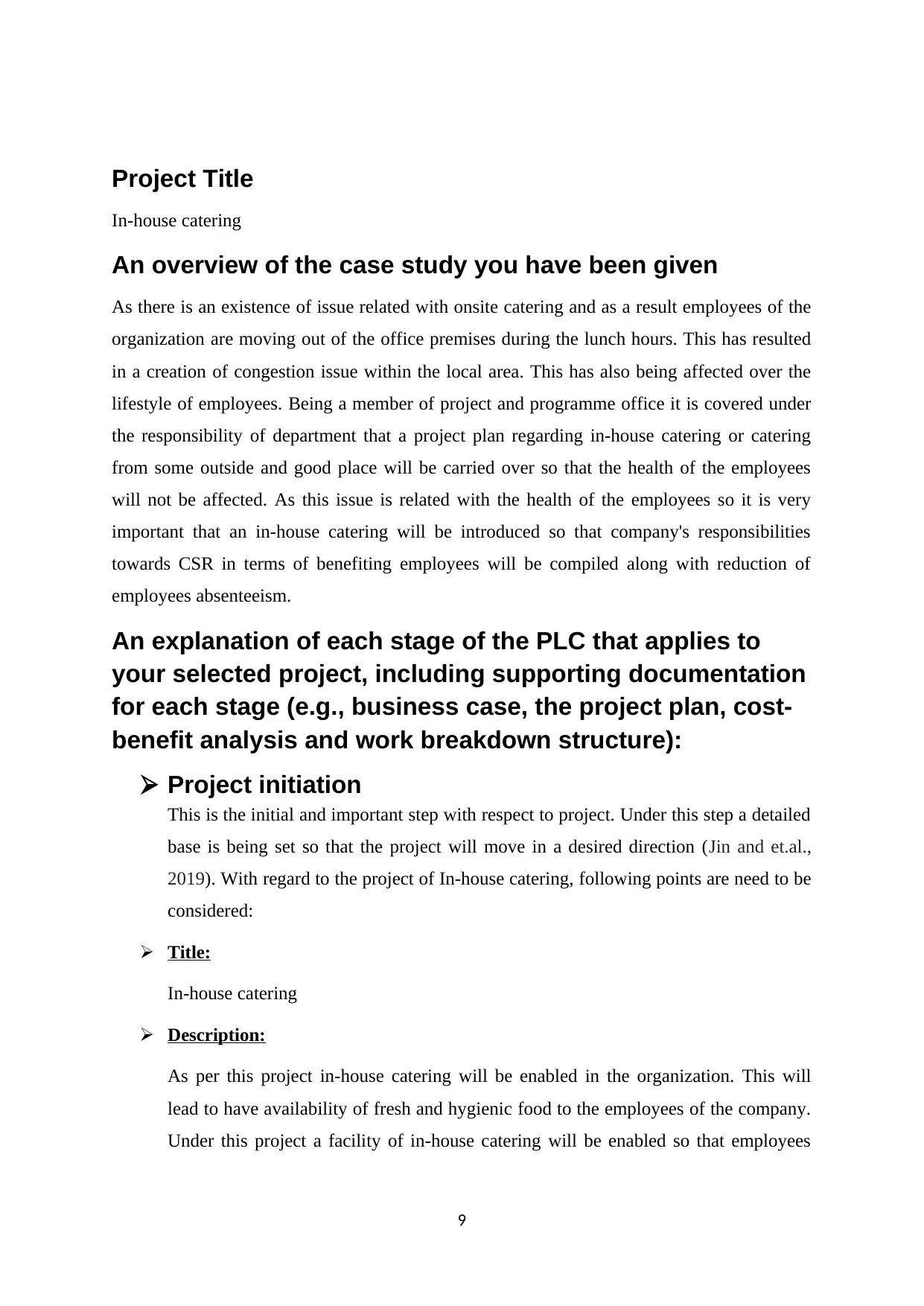
Project Title
In-house catering
An overview of the case study you have been given
As there is an existence of issue related with onsite catering and as a result employees of the
organization are moving out of the office premises during the lunch hours. This has resulted
in a creation of congestion issue within the local area. This has also being affected over the
lifestyle of employees. Being a member of project and programme office it is covered under
the responsibility of department that a project plan regarding in-house catering or catering
from some outside and good place will be carried over so that the health of the employees
will not be affected. As this issue is related with the health of the employees so it is very
important that an in-house catering will be introduced so that company's responsibilities
towards CSR in terms of benefiting employees will be compiled along with reduction of
employees absenteeism.
An explanation of each stage of the PLC that applies to
your selected project, including supporting documentation
for each stage (e.g., business case, the project plan, cost-
benefit analysis and work breakdown structure):
Project initiation
This is the initial and important step with respect to project. Under this step a detailed
base is being set so that the project will move in a desired direction (Jin and et.al.,
2019). With regard to the project of In-house catering, following points are need to be
considered:
Title:
In-house catering
Description:
As per this project in-house catering will be enabled in the organization. This will
lead to have availability of fresh and hygienic food to the employees of the company.
Under this project a facility of in-house catering will be enabled so that employees
9
In-house catering
An overview of the case study you have been given
As there is an existence of issue related with onsite catering and as a result employees of the
organization are moving out of the office premises during the lunch hours. This has resulted
in a creation of congestion issue within the local area. This has also being affected over the
lifestyle of employees. Being a member of project and programme office it is covered under
the responsibility of department that a project plan regarding in-house catering or catering
from some outside and good place will be carried over so that the health of the employees
will not be affected. As this issue is related with the health of the employees so it is very
important that an in-house catering will be introduced so that company's responsibilities
towards CSR in terms of benefiting employees will be compiled along with reduction of
employees absenteeism.
An explanation of each stage of the PLC that applies to
your selected project, including supporting documentation
for each stage (e.g., business case, the project plan, cost-
benefit analysis and work breakdown structure):
Project initiation
This is the initial and important step with respect to project. Under this step a detailed
base is being set so that the project will move in a desired direction (Jin and et.al.,
2019). With regard to the project of In-house catering, following points are need to be
considered:
Title:
In-house catering
Description:
As per this project in-house catering will be enabled in the organization. This will
lead to have availability of fresh and hygienic food to the employees of the company.
Under this project a facility of in-house catering will be enabled so that employees
9
Secure Best Marks with AI Grader
Need help grading? Try our AI Grader for instant feedback on your assignments.
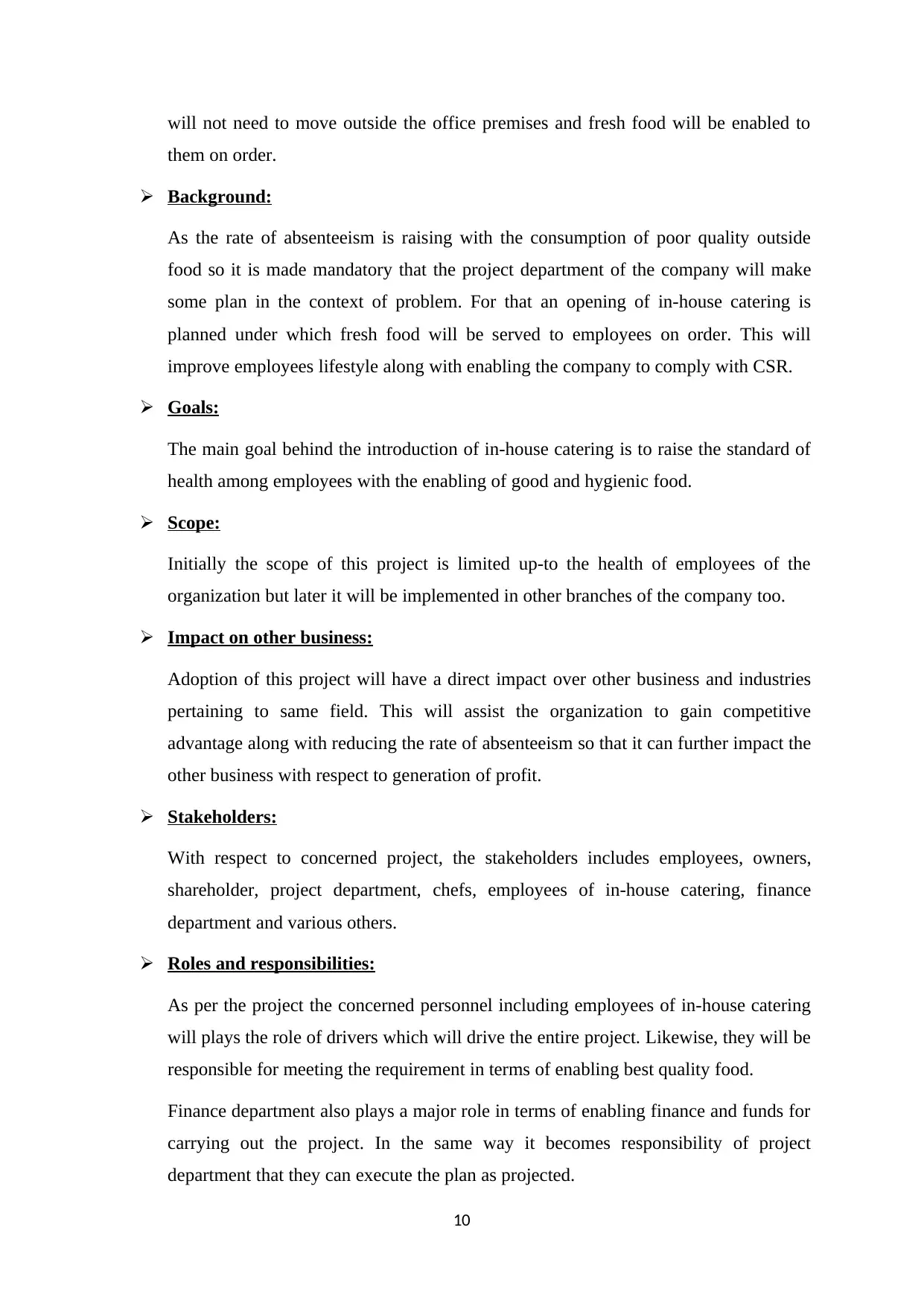
will not need to move outside the office premises and fresh food will be enabled to
them on order.
Background:
As the rate of absenteeism is raising with the consumption of poor quality outside
food so it is made mandatory that the project department of the company will make
some plan in the context of problem. For that an opening of in-house catering is
planned under which fresh food will be served to employees on order. This will
improve employees lifestyle along with enabling the company to comply with CSR.
Goals:
The main goal behind the introduction of in-house catering is to raise the standard of
health among employees with the enabling of good and hygienic food.
Scope:
Initially the scope of this project is limited up-to the health of employees of the
organization but later it will be implemented in other branches of the company too.
Impact on other business:
Adoption of this project will have a direct impact over other business and industries
pertaining to same field. This will assist the organization to gain competitive
advantage along with reducing the rate of absenteeism so that it can further impact the
other business with respect to generation of profit.
Stakeholders:
With respect to concerned project, the stakeholders includes employees, owners,
shareholder, project department, chefs, employees of in-house catering, finance
department and various others.
Roles and responsibilities:
As per the project the concerned personnel including employees of in-house catering
will plays the role of drivers which will drive the entire project. Likewise, they will be
responsible for meeting the requirement in terms of enabling best quality food.
Finance department also plays a major role in terms of enabling finance and funds for
carrying out the project. In the same way it becomes responsibility of project
department that they can execute the plan as projected.
10
them on order.
Background:
As the rate of absenteeism is raising with the consumption of poor quality outside
food so it is made mandatory that the project department of the company will make
some plan in the context of problem. For that an opening of in-house catering is
planned under which fresh food will be served to employees on order. This will
improve employees lifestyle along with enabling the company to comply with CSR.
Goals:
The main goal behind the introduction of in-house catering is to raise the standard of
health among employees with the enabling of good and hygienic food.
Scope:
Initially the scope of this project is limited up-to the health of employees of the
organization but later it will be implemented in other branches of the company too.
Impact on other business:
Adoption of this project will have a direct impact over other business and industries
pertaining to same field. This will assist the organization to gain competitive
advantage along with reducing the rate of absenteeism so that it can further impact the
other business with respect to generation of profit.
Stakeholders:
With respect to concerned project, the stakeholders includes employees, owners,
shareholder, project department, chefs, employees of in-house catering, finance
department and various others.
Roles and responsibilities:
As per the project the concerned personnel including employees of in-house catering
will plays the role of drivers which will drive the entire project. Likewise, they will be
responsible for meeting the requirement in terms of enabling best quality food.
Finance department also plays a major role in terms of enabling finance and funds for
carrying out the project. In the same way it becomes responsibility of project
department that they can execute the plan as projected.
10
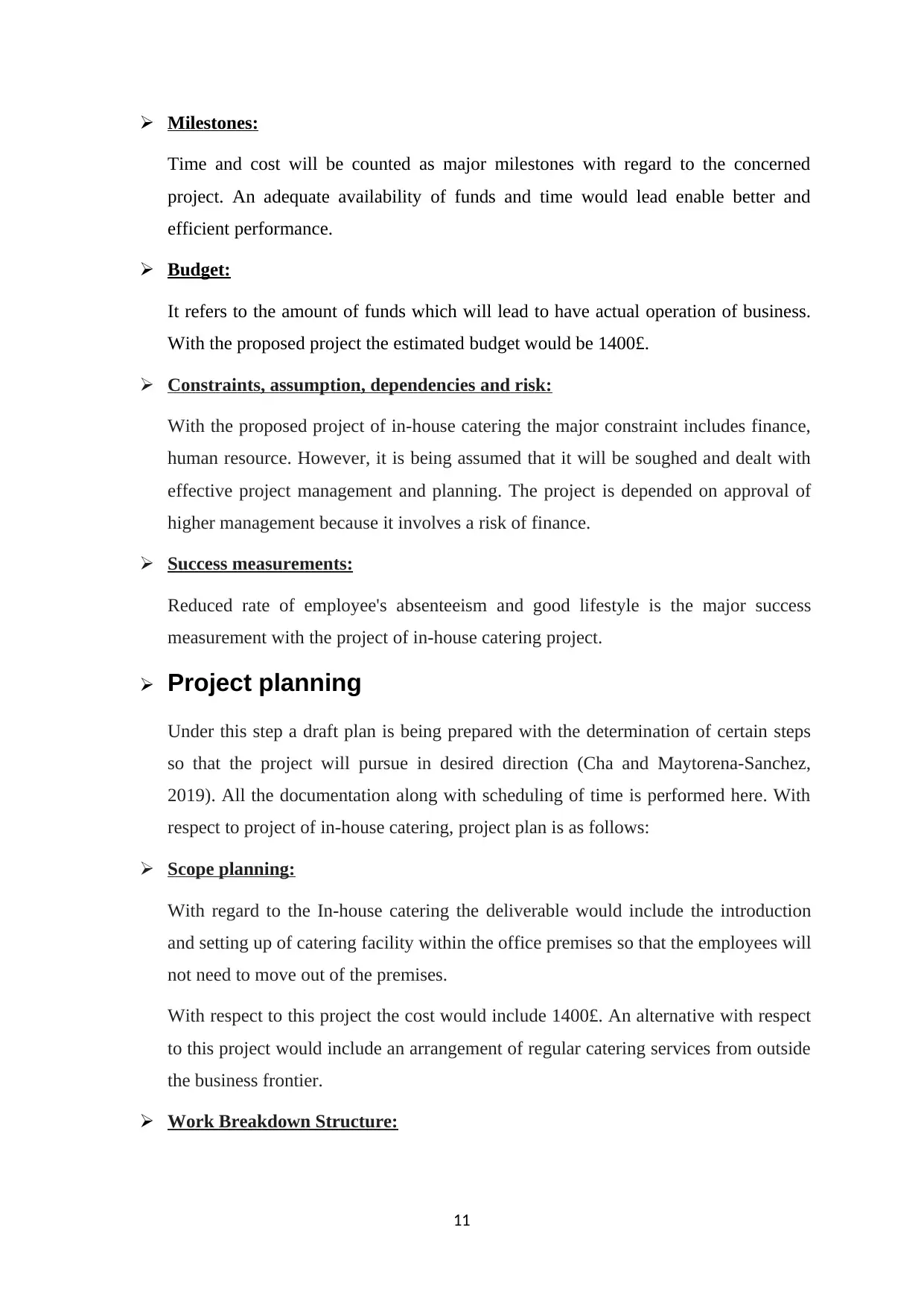
Milestones:
Time and cost will be counted as major milestones with regard to the concerned
project. An adequate availability of funds and time would lead enable better and
efficient performance.
Budget:
It refers to the amount of funds which will lead to have actual operation of business.
With the proposed project the estimated budget would be 1400£.
Constraints, assumption, dependencies and risk:
With the proposed project of in-house catering the major constraint includes finance,
human resource. However, it is being assumed that it will be soughed and dealt with
effective project management and planning. The project is depended on approval of
higher management because it involves a risk of finance.
Success measurements:
Reduced rate of employee's absenteeism and good lifestyle is the major success
measurement with the project of in-house catering project.
Project planning
Under this step a draft plan is being prepared with the determination of certain steps
so that the project will pursue in desired direction (Cha and Maytorena-Sanchez,
2019). All the documentation along with scheduling of time is performed here. With
respect to project of in-house catering, project plan is as follows:
Scope planning:
With regard to the In-house catering the deliverable would include the introduction
and setting up of catering facility within the office premises so that the employees will
not need to move out of the premises.
With respect to this project the cost would include 1400£. An alternative with respect
to this project would include an arrangement of regular catering services from outside
the business frontier.
Work Breakdown Structure:
11
Time and cost will be counted as major milestones with regard to the concerned
project. An adequate availability of funds and time would lead enable better and
efficient performance.
Budget:
It refers to the amount of funds which will lead to have actual operation of business.
With the proposed project the estimated budget would be 1400£.
Constraints, assumption, dependencies and risk:
With the proposed project of in-house catering the major constraint includes finance,
human resource. However, it is being assumed that it will be soughed and dealt with
effective project management and planning. The project is depended on approval of
higher management because it involves a risk of finance.
Success measurements:
Reduced rate of employee's absenteeism and good lifestyle is the major success
measurement with the project of in-house catering project.
Project planning
Under this step a draft plan is being prepared with the determination of certain steps
so that the project will pursue in desired direction (Cha and Maytorena-Sanchez,
2019). All the documentation along with scheduling of time is performed here. With
respect to project of in-house catering, project plan is as follows:
Scope planning:
With regard to the In-house catering the deliverable would include the introduction
and setting up of catering facility within the office premises so that the employees will
not need to move out of the premises.
With respect to this project the cost would include 1400£. An alternative with respect
to this project would include an arrangement of regular catering services from outside
the business frontier.
Work Breakdown Structure:
11
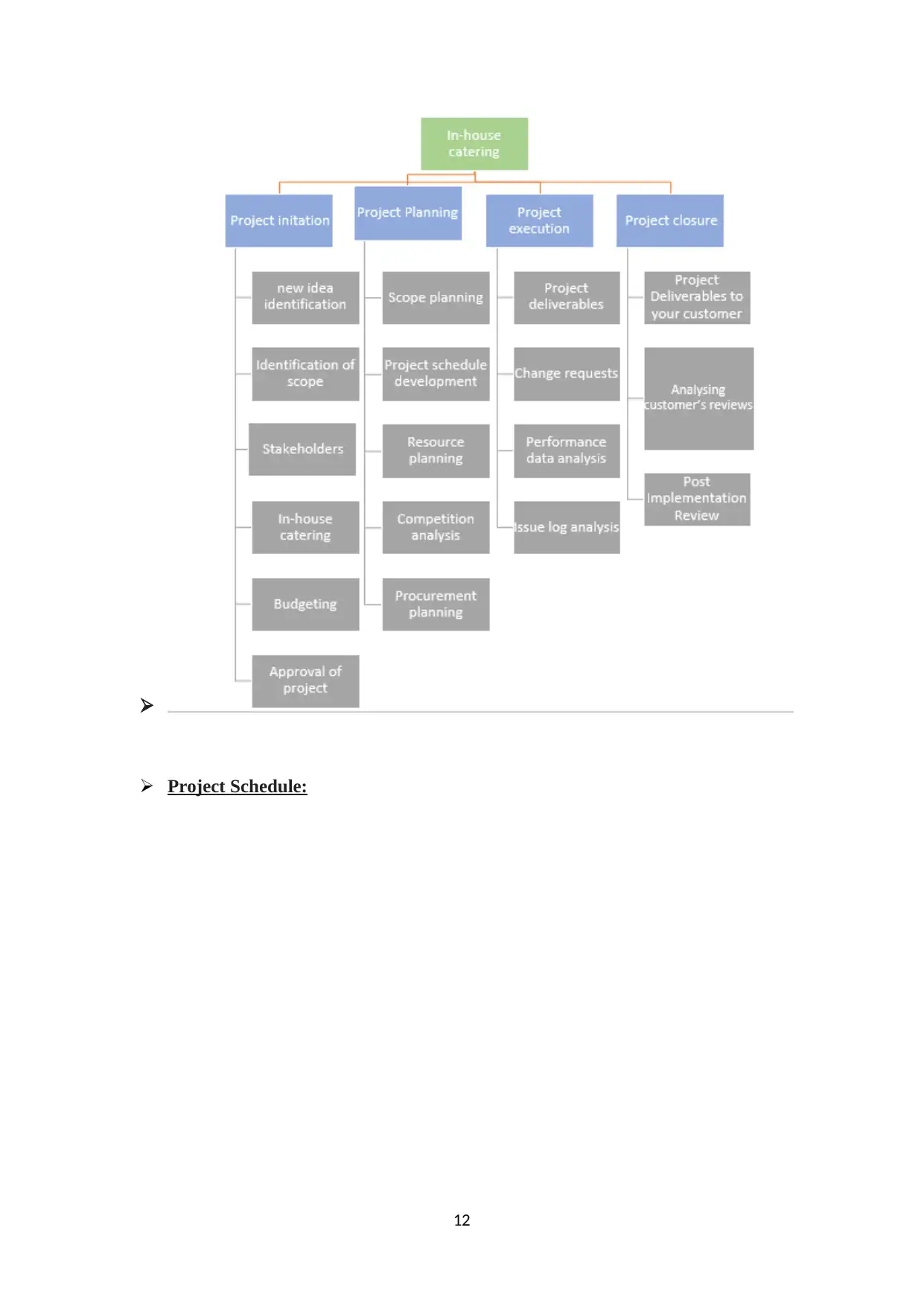
Project Schedule:
12
Project Schedule:
12
Paraphrase This Document
Need a fresh take? Get an instant paraphrase of this document with our AI Paraphraser
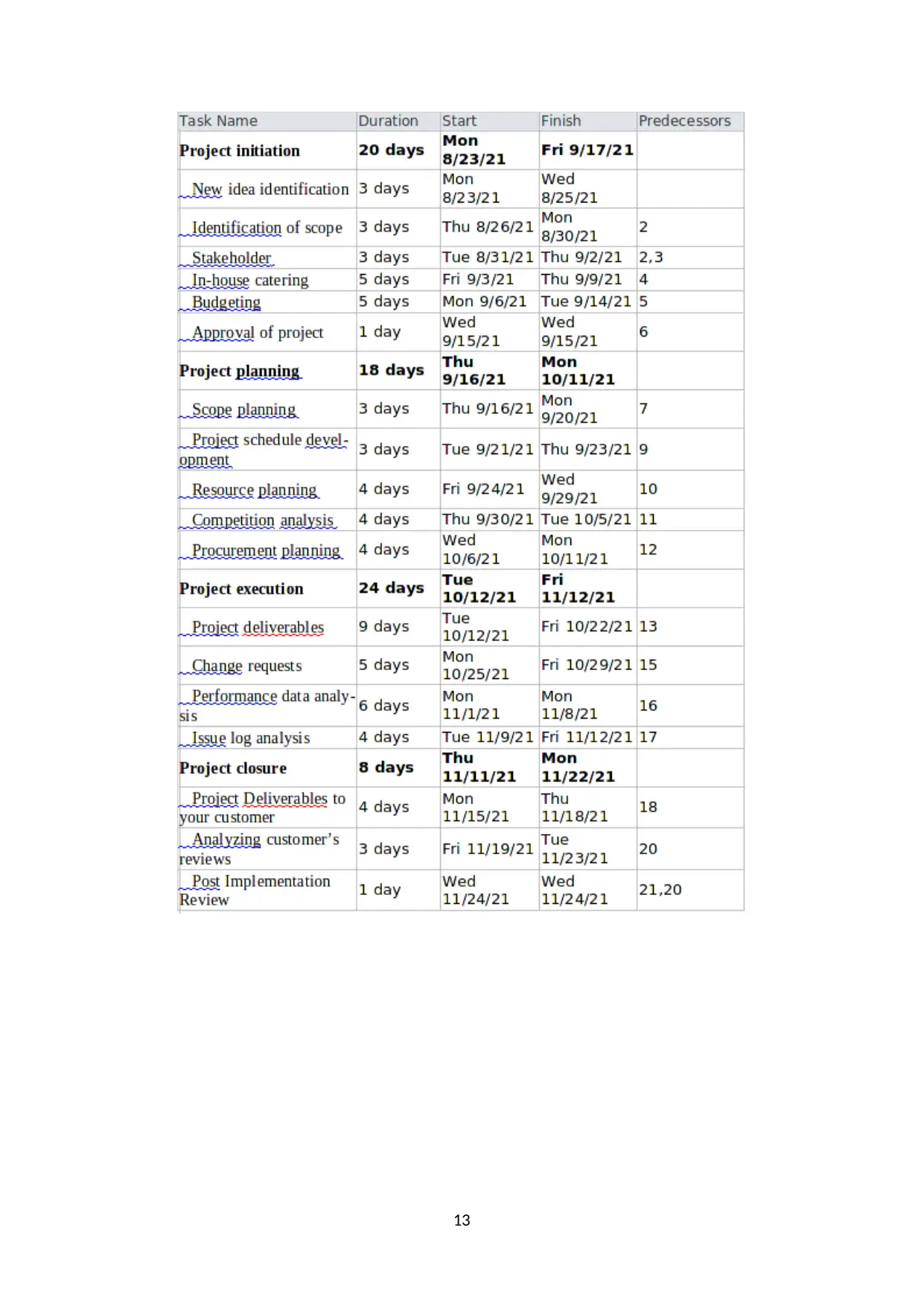
13
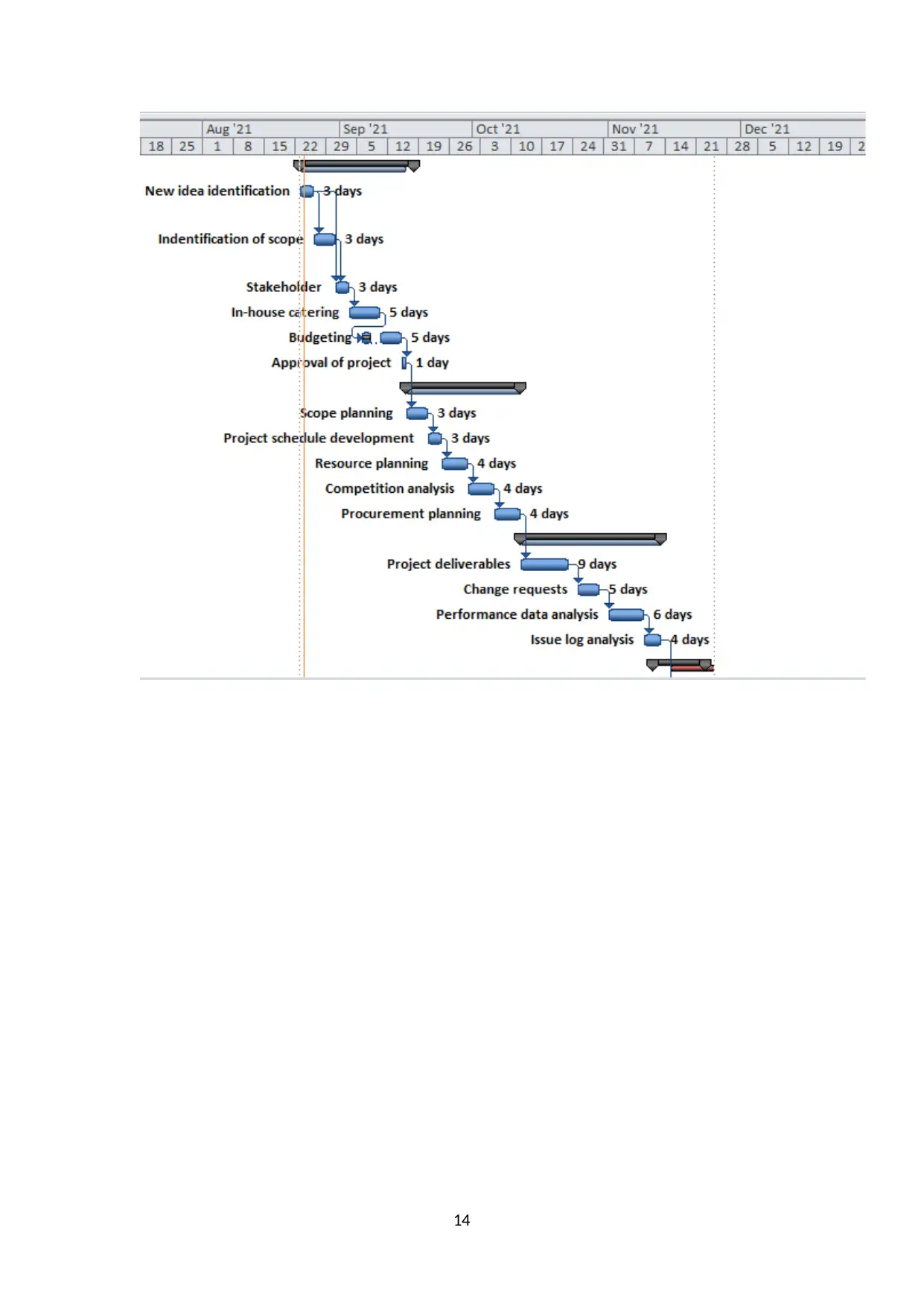
14
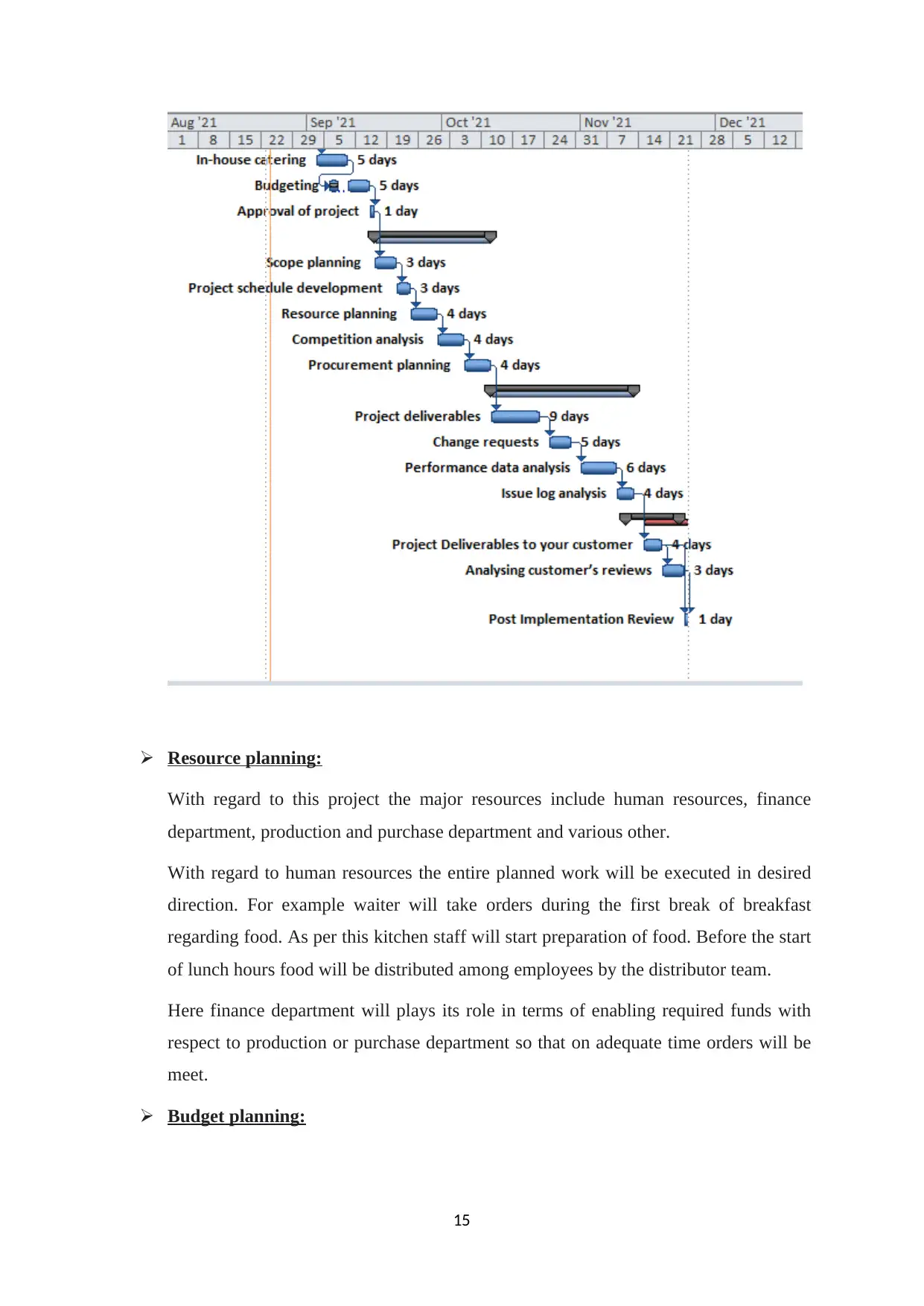
Resource planning:
With regard to this project the major resources include human resources, finance
department, production and purchase department and various other.
With regard to human resources the entire planned work will be executed in desired
direction. For example waiter will take orders during the first break of breakfast
regarding food. As per this kitchen staff will start preparation of food. Before the start
of lunch hours food will be distributed among employees by the distributor team.
Here finance department will plays its role in terms of enabling required funds with
respect to production or purchase department so that on adequate time orders will be
meet.
Budget planning:
15
With regard to this project the major resources include human resources, finance
department, production and purchase department and various other.
With regard to human resources the entire planned work will be executed in desired
direction. For example waiter will take orders during the first break of breakfast
regarding food. As per this kitchen staff will start preparation of food. Before the start
of lunch hours food will be distributed among employees by the distributor team.
Here finance department will plays its role in terms of enabling required funds with
respect to production or purchase department so that on adequate time orders will be
meet.
Budget planning:
15
Secure Best Marks with AI Grader
Need help grading? Try our AI Grader for instant feedback on your assignments.

The budgeted cost would be around 1400£. This will include the cost of purchase of
equipment which will be used in cooking. Likewise, a kitchen set-up cost will also be
included in this plan. Salaries to kitchen staff is also included in this.
Procurement plan:
Under this plan contract with suppliers and other outside agencies will be included (de
Araújo, Alencar and de Miranda Mota, 2017). This will include contract with the
suppliers of food and vegetables along with other personnel which are deal with
kitchen essential. This will also include contract with employment agencies which
will plays its role in terms of delivering adequate employees with regard to this
project.
Risk management:
The risk with regard to this project involves low attraction of employees towards the
daily and normal food. In order to meet this risk special menu is designed under
which choice of healthy as well as fast food is given.
Another risk involves shortage of funds. This will be mitigated with the adequate
distribution of funds. For example enabling less variety ion initial phase and later
allowing diverse rage.
Quality planning:
The quality criteria will mainly related with the quality of food in terms of its hygiene
and healthiness. Likewise, fresh deliverable with the best quality ingredients will be
used.
Communication planning:
Communication with the concerned stakeholder will take place through the use of
online medium including e-mail and informal too. This cane be understood as
communication between finance department, owners, suppliers will all be done on e-
mail as written communication. While communication with employees as customer
will take place through offline mode including taking of direct orders from waiters.
Project execution
As per this phase the entire project will be executed and put to work. Under this stage
the planned strategies will be implemented (Meredith, Shafer and Mantel Jr, 2017).
This will lead to have a production of results in terms of outcome. As deliverable of
16
equipment which will be used in cooking. Likewise, a kitchen set-up cost will also be
included in this plan. Salaries to kitchen staff is also included in this.
Procurement plan:
Under this plan contract with suppliers and other outside agencies will be included (de
Araújo, Alencar and de Miranda Mota, 2017). This will include contract with the
suppliers of food and vegetables along with other personnel which are deal with
kitchen essential. This will also include contract with employment agencies which
will plays its role in terms of delivering adequate employees with regard to this
project.
Risk management:
The risk with regard to this project involves low attraction of employees towards the
daily and normal food. In order to meet this risk special menu is designed under
which choice of healthy as well as fast food is given.
Another risk involves shortage of funds. This will be mitigated with the adequate
distribution of funds. For example enabling less variety ion initial phase and later
allowing diverse rage.
Quality planning:
The quality criteria will mainly related with the quality of food in terms of its hygiene
and healthiness. Likewise, fresh deliverable with the best quality ingredients will be
used.
Communication planning:
Communication with the concerned stakeholder will take place through the use of
online medium including e-mail and informal too. This cane be understood as
communication between finance department, owners, suppliers will all be done on e-
mail as written communication. While communication with employees as customer
will take place through offline mode including taking of direct orders from waiters.
Project execution
As per this phase the entire project will be executed and put to work. Under this stage
the planned strategies will be implemented (Meredith, Shafer and Mantel Jr, 2017).
This will lead to have a production of results in terms of outcome. As deliverable of
16
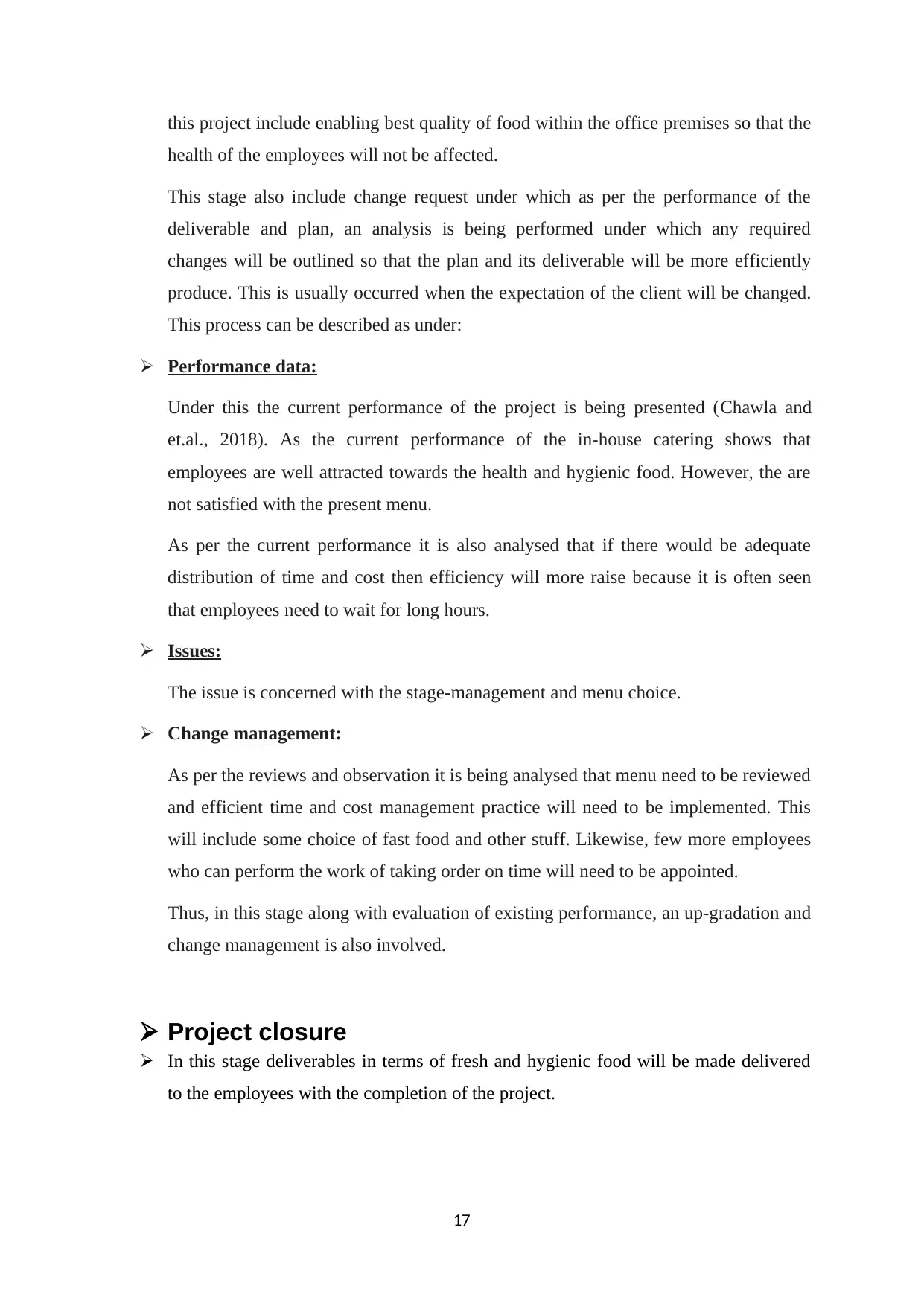
this project include enabling best quality of food within the office premises so that the
health of the employees will not be affected.
This stage also include change request under which as per the performance of the
deliverable and plan, an analysis is being performed under which any required
changes will be outlined so that the plan and its deliverable will be more efficiently
produce. This is usually occurred when the expectation of the client will be changed.
This process can be described as under:
Performance data:
Under this the current performance of the project is being presented (Chawla and
et.al., 2018). As the current performance of the in-house catering shows that
employees are well attracted towards the health and hygienic food. However, the are
not satisfied with the present menu.
As per the current performance it is also analysed that if there would be adequate
distribution of time and cost then efficiency will more raise because it is often seen
that employees need to wait for long hours.
Issues:
The issue is concerned with the stage-management and menu choice.
Change management:
As per the reviews and observation it is being analysed that menu need to be reviewed
and efficient time and cost management practice will need to be implemented. This
will include some choice of fast food and other stuff. Likewise, few more employees
who can perform the work of taking order on time will need to be appointed.
Thus, in this stage along with evaluation of existing performance, an up-gradation and
change management is also involved.
Project closure
In this stage deliverables in terms of fresh and hygienic food will be made delivered
to the employees with the completion of the project.
17
health of the employees will not be affected.
This stage also include change request under which as per the performance of the
deliverable and plan, an analysis is being performed under which any required
changes will be outlined so that the plan and its deliverable will be more efficiently
produce. This is usually occurred when the expectation of the client will be changed.
This process can be described as under:
Performance data:
Under this the current performance of the project is being presented (Chawla and
et.al., 2018). As the current performance of the in-house catering shows that
employees are well attracted towards the health and hygienic food. However, the are
not satisfied with the present menu.
As per the current performance it is also analysed that if there would be adequate
distribution of time and cost then efficiency will more raise because it is often seen
that employees need to wait for long hours.
Issues:
The issue is concerned with the stage-management and menu choice.
Change management:
As per the reviews and observation it is being analysed that menu need to be reviewed
and efficient time and cost management practice will need to be implemented. This
will include some choice of fast food and other stuff. Likewise, few more employees
who can perform the work of taking order on time will need to be appointed.
Thus, in this stage along with evaluation of existing performance, an up-gradation and
change management is also involved.
Project closure
In this stage deliverables in terms of fresh and hygienic food will be made delivered
to the employees with the completion of the project.
17
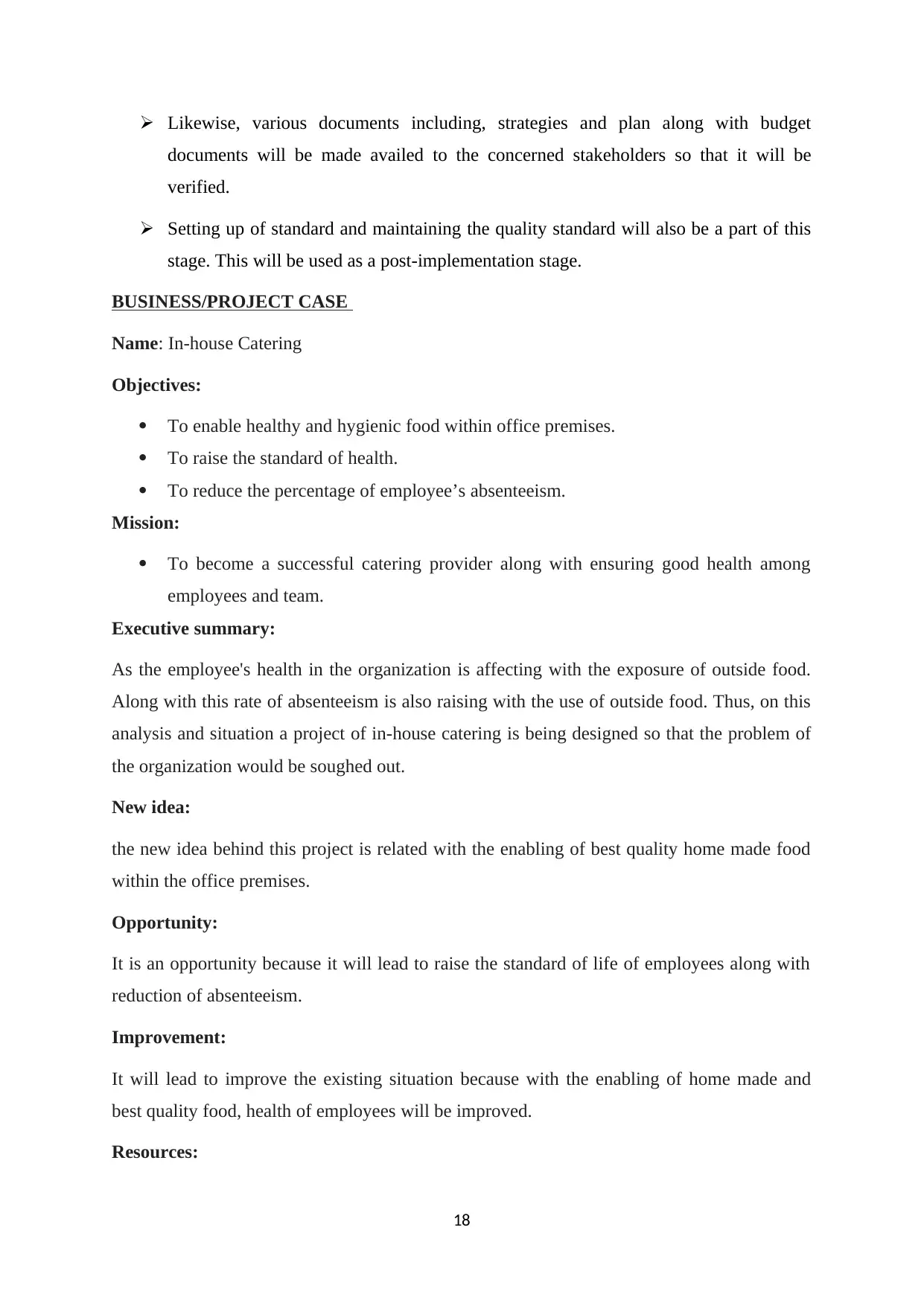
Likewise, various documents including, strategies and plan along with budget
documents will be made availed to the concerned stakeholders so that it will be
verified.
Setting up of standard and maintaining the quality standard will also be a part of this
stage. This will be used as a post-implementation stage.
BUSINESS/PROJECT CASE
Name: In-house Catering
Objectives:
To enable healthy and hygienic food within office premises.
To raise the standard of health.
To reduce the percentage of employee’s absenteeism.
Mission:
To become a successful catering provider along with ensuring good health among
employees and team.
Executive summary:
As the employee's health in the organization is affecting with the exposure of outside food.
Along with this rate of absenteeism is also raising with the use of outside food. Thus, on this
analysis and situation a project of in-house catering is being designed so that the problem of
the organization would be soughed out.
New idea:
the new idea behind this project is related with the enabling of best quality home made food
within the office premises.
Opportunity:
It is an opportunity because it will lead to raise the standard of life of employees along with
reduction of absenteeism.
Improvement:
It will lead to improve the existing situation because with the enabling of home made and
best quality food, health of employees will be improved.
Resources:
18
documents will be made availed to the concerned stakeholders so that it will be
verified.
Setting up of standard and maintaining the quality standard will also be a part of this
stage. This will be used as a post-implementation stage.
BUSINESS/PROJECT CASE
Name: In-house Catering
Objectives:
To enable healthy and hygienic food within office premises.
To raise the standard of health.
To reduce the percentage of employee’s absenteeism.
Mission:
To become a successful catering provider along with ensuring good health among
employees and team.
Executive summary:
As the employee's health in the organization is affecting with the exposure of outside food.
Along with this rate of absenteeism is also raising with the use of outside food. Thus, on this
analysis and situation a project of in-house catering is being designed so that the problem of
the organization would be soughed out.
New idea:
the new idea behind this project is related with the enabling of best quality home made food
within the office premises.
Opportunity:
It is an opportunity because it will lead to raise the standard of life of employees along with
reduction of absenteeism.
Improvement:
It will lead to improve the existing situation because with the enabling of home made and
best quality food, health of employees will be improved.
Resources:
18
Paraphrase This Document
Need a fresh take? Get an instant paraphrase of this document with our AI Paraphraser
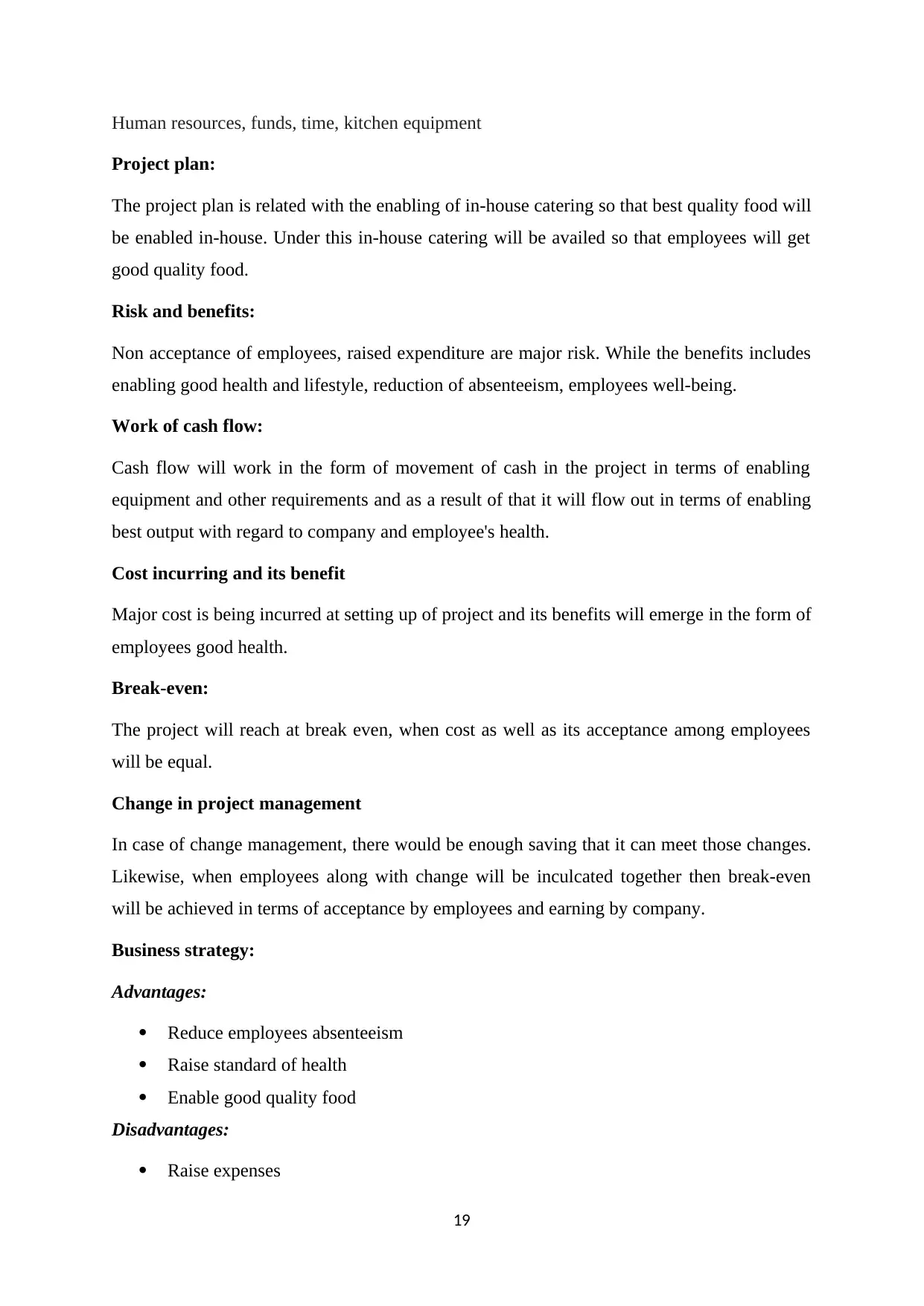
Human resources, funds, time, kitchen equipment
Project plan:
The project plan is related with the enabling of in-house catering so that best quality food will
be enabled in-house. Under this in-house catering will be availed so that employees will get
good quality food.
Risk and benefits:
Non acceptance of employees, raised expenditure are major risk. While the benefits includes
enabling good health and lifestyle, reduction of absenteeism, employees well-being.
Work of cash flow:
Cash flow will work in the form of movement of cash in the project in terms of enabling
equipment and other requirements and as a result of that it will flow out in terms of enabling
best output with regard to company and employee's health.
Cost incurring and its benefit
Major cost is being incurred at setting up of project and its benefits will emerge in the form of
employees good health.
Break-even:
The project will reach at break even, when cost as well as its acceptance among employees
will be equal.
Change in project management
In case of change management, there would be enough saving that it can meet those changes.
Likewise, when employees along with change will be inculcated together then break-even
will be achieved in terms of acceptance by employees and earning by company.
Business strategy:
Advantages:
Reduce employees absenteeism
Raise standard of health
Enable good quality food
Disadvantages:
Raise expenses
19
Project plan:
The project plan is related with the enabling of in-house catering so that best quality food will
be enabled in-house. Under this in-house catering will be availed so that employees will get
good quality food.
Risk and benefits:
Non acceptance of employees, raised expenditure are major risk. While the benefits includes
enabling good health and lifestyle, reduction of absenteeism, employees well-being.
Work of cash flow:
Cash flow will work in the form of movement of cash in the project in terms of enabling
equipment and other requirements and as a result of that it will flow out in terms of enabling
best output with regard to company and employee's health.
Cost incurring and its benefit
Major cost is being incurred at setting up of project and its benefits will emerge in the form of
employees good health.
Break-even:
The project will reach at break even, when cost as well as its acceptance among employees
will be equal.
Change in project management
In case of change management, there would be enough saving that it can meet those changes.
Likewise, when employees along with change will be inculcated together then break-even
will be achieved in terms of acceptance by employees and earning by company.
Business strategy:
Advantages:
Reduce employees absenteeism
Raise standard of health
Enable good quality food
Disadvantages:
Raise expenses
19
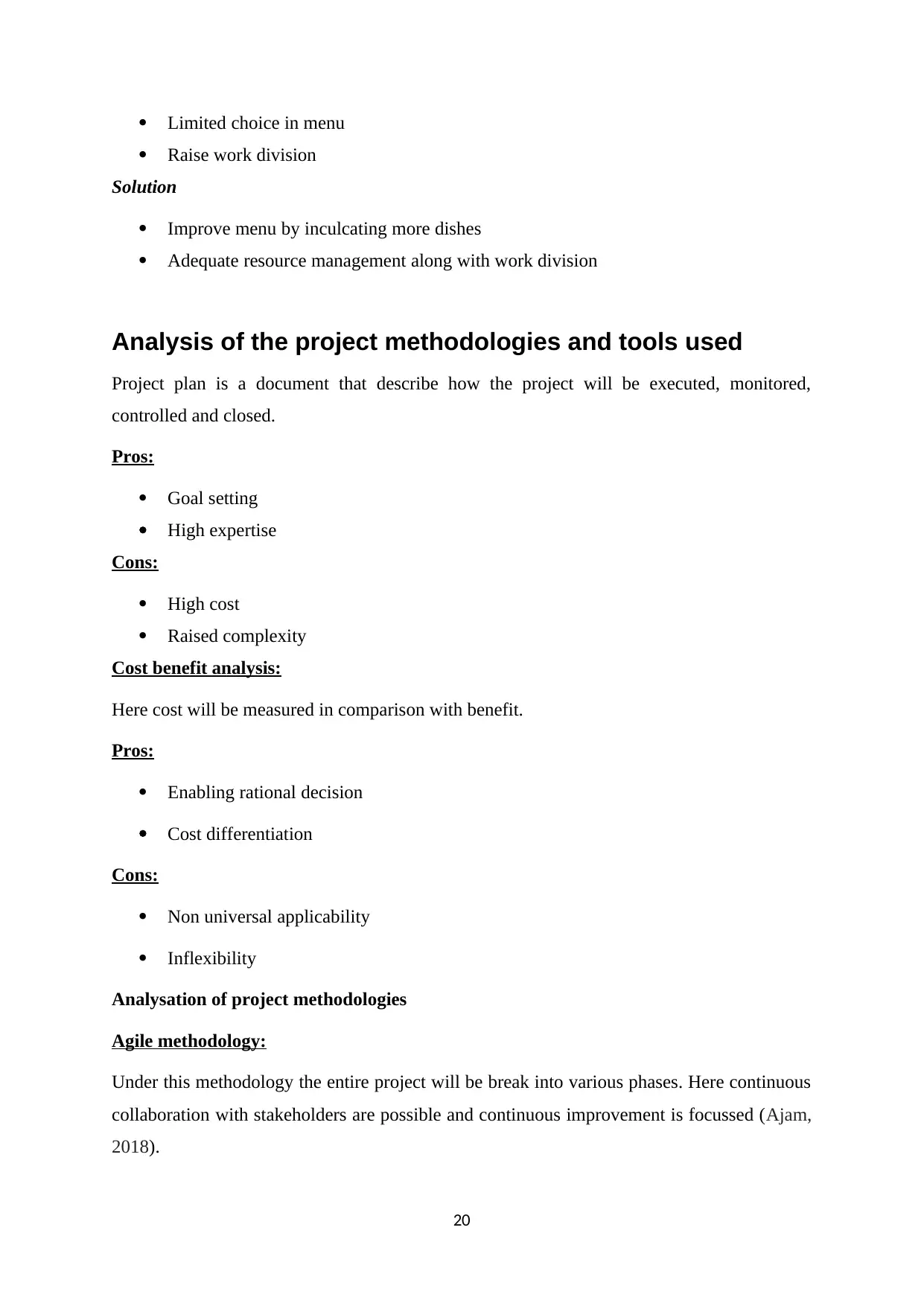
Limited choice in menu
Raise work division
Solution
Improve menu by inculcating more dishes
Adequate resource management along with work division
Analysis of the project methodologies and tools used
Project plan is a document that describe how the project will be executed, monitored,
controlled and closed.
Pros:
Goal setting
High expertise
Cons:
High cost
Raised complexity
Cost benefit analysis:
Here cost will be measured in comparison with benefit.
Pros:
Enabling rational decision
Cost differentiation
Cons:
Non universal applicability
Inflexibility
Analysation of project methodologies
Agile methodology:
Under this methodology the entire project will be break into various phases. Here continuous
collaboration with stakeholders are possible and continuous improvement is focussed (Ajam,
2018).
20
Raise work division
Solution
Improve menu by inculcating more dishes
Adequate resource management along with work division
Analysis of the project methodologies and tools used
Project plan is a document that describe how the project will be executed, monitored,
controlled and closed.
Pros:
Goal setting
High expertise
Cons:
High cost
Raised complexity
Cost benefit analysis:
Here cost will be measured in comparison with benefit.
Pros:
Enabling rational decision
Cost differentiation
Cons:
Non universal applicability
Inflexibility
Analysation of project methodologies
Agile methodology:
Under this methodology the entire project will be break into various phases. Here continuous
collaboration with stakeholders are possible and continuous improvement is focussed (Ajam,
2018).
20

Pros:
Better control
Reduce risk
Continuous improvement
Cons:
Poor planning of resources
Fragmented results
Complex measurement
Project management tools:
Work breakdown structure:
Under this tool the entire work will be break among various phases (Burghate, 2018).
Pros:
Easy operation
Clarity in roles and responsibilities
Cons:
Time consuming
Poor decision-making
Review and critically evaluate the effectiveness of the PLC
in application to your project using the appropriate
theories models and concepts
PLC with regard to the current process plays an important role in terms of execution of
project along with its performance measurement. Likewise, setting up of standard lead to
raise the efficiency of the project. All the steps of the PLC contribute a major role in terms of
enhancing the project outcome (Frefer and et.al., 2018). Monitoring will lead to have an
important role in terms of performance measurement along with taking adequate action.
However, on a critical note the entire process was time-consuming and involves high cost. It
has also lead to delay in decision-making.
21
Better control
Reduce risk
Continuous improvement
Cons:
Poor planning of resources
Fragmented results
Complex measurement
Project management tools:
Work breakdown structure:
Under this tool the entire work will be break among various phases (Burghate, 2018).
Pros:
Easy operation
Clarity in roles and responsibilities
Cons:
Time consuming
Poor decision-making
Review and critically evaluate the effectiveness of the PLC
in application to your project using the appropriate
theories models and concepts
PLC with regard to the current process plays an important role in terms of execution of
project along with its performance measurement. Likewise, setting up of standard lead to
raise the efficiency of the project. All the steps of the PLC contribute a major role in terms of
enhancing the project outcome (Frefer and et.al., 2018). Monitoring will lead to have an
important role in terms of performance measurement along with taking adequate action.
However, on a critical note the entire process was time-consuming and involves high cost. It
has also lead to delay in decision-making.
21
Secure Best Marks with AI Grader
Need help grading? Try our AI Grader for instant feedback on your assignments.
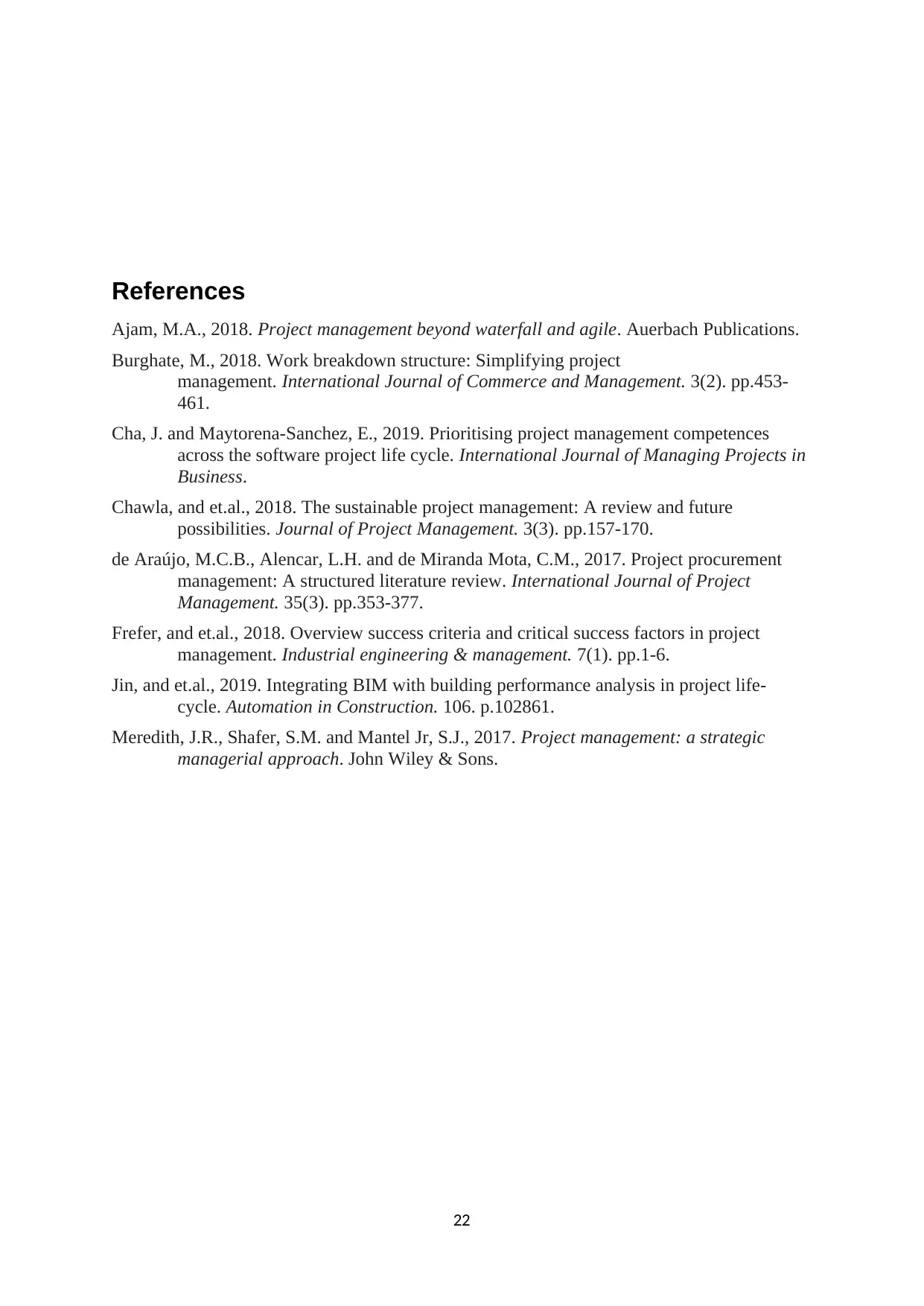
References
Ajam, M.A., 2018. Project management beyond waterfall and agile. Auerbach Publications.
Burghate, M., 2018. Work breakdown structure: Simplifying project
management. International Journal of Commerce and Management. 3(2). pp.453-
461.
Cha, J. and Maytorena-Sanchez, E., 2019. Prioritising project management competences
across the software project life cycle. International Journal of Managing Projects in
Business.
Chawla, and et.al., 2018. The sustainable project management: A review and future
possibilities. Journal of Project Management. 3(3). pp.157-170.
de Araújo, M.C.B., Alencar, L.H. and de Miranda Mota, C.M., 2017. Project procurement
management: A structured literature review. International Journal of Project
Management. 35(3). pp.353-377.
Frefer, and et.al., 2018. Overview success criteria and critical success factors in project
management. Industrial engineering & management. 7(1). pp.1-6.
Jin, and et.al., 2019. Integrating BIM with building performance analysis in project life-
cycle. Automation in Construction. 106. p.102861.
Meredith, J.R., Shafer, S.M. and Mantel Jr, S.J., 2017. Project management: a strategic
managerial approach. John Wiley & Sons.
22
Ajam, M.A., 2018. Project management beyond waterfall and agile. Auerbach Publications.
Burghate, M., 2018. Work breakdown structure: Simplifying project
management. International Journal of Commerce and Management. 3(2). pp.453-
461.
Cha, J. and Maytorena-Sanchez, E., 2019. Prioritising project management competences
across the software project life cycle. International Journal of Managing Projects in
Business.
Chawla, and et.al., 2018. The sustainable project management: A review and future
possibilities. Journal of Project Management. 3(3). pp.157-170.
de Araújo, M.C.B., Alencar, L.H. and de Miranda Mota, C.M., 2017. Project procurement
management: A structured literature review. International Journal of Project
Management. 35(3). pp.353-377.
Frefer, and et.al., 2018. Overview success criteria and critical success factors in project
management. Industrial engineering & management. 7(1). pp.1-6.
Jin, and et.al., 2019. Integrating BIM with building performance analysis in project life-
cycle. Automation in Construction. 106. p.102861.
Meredith, J.R., Shafer, S.M. and Mantel Jr, S.J., 2017. Project management: a strategic
managerial approach. John Wiley & Sons.
22
1 out of 23
Related Documents
Your All-in-One AI-Powered Toolkit for Academic Success.
+13062052269
info@desklib.com
Available 24*7 on WhatsApp / Email
![[object Object]](/_next/static/media/star-bottom.7253800d.svg)
Unlock your academic potential
© 2024 | Zucol Services PVT LTD | All rights reserved.
